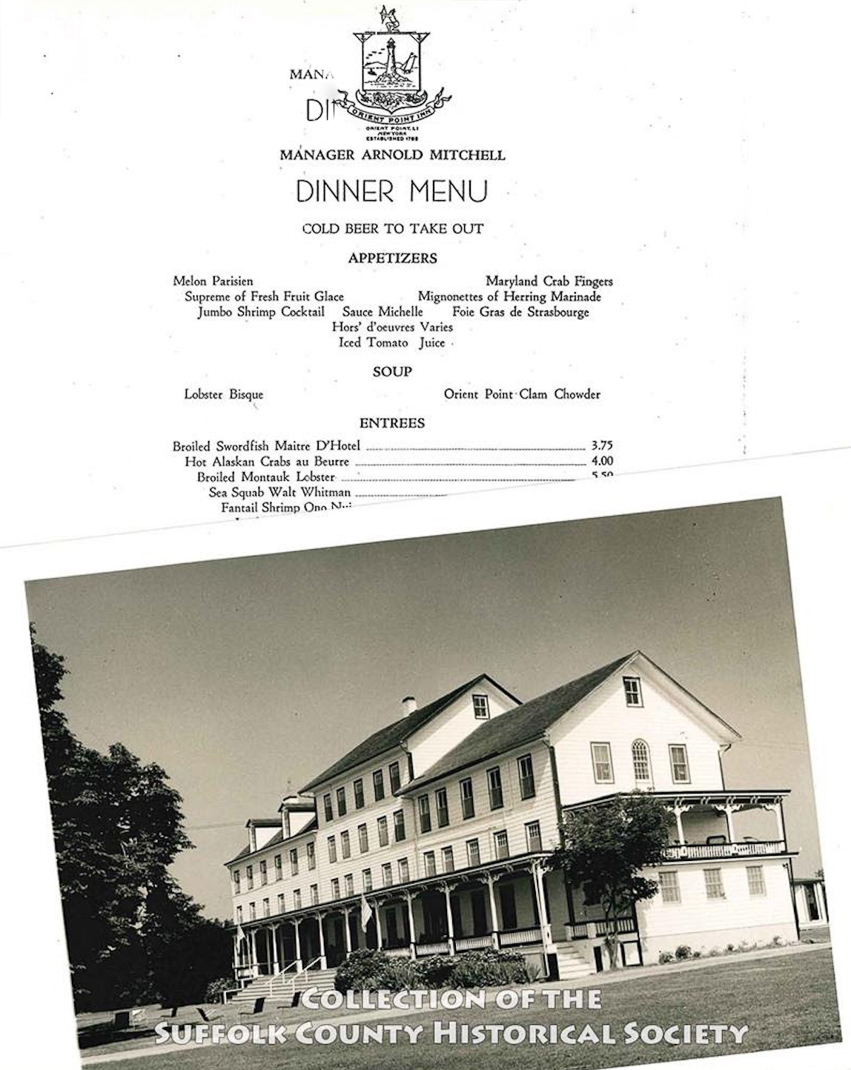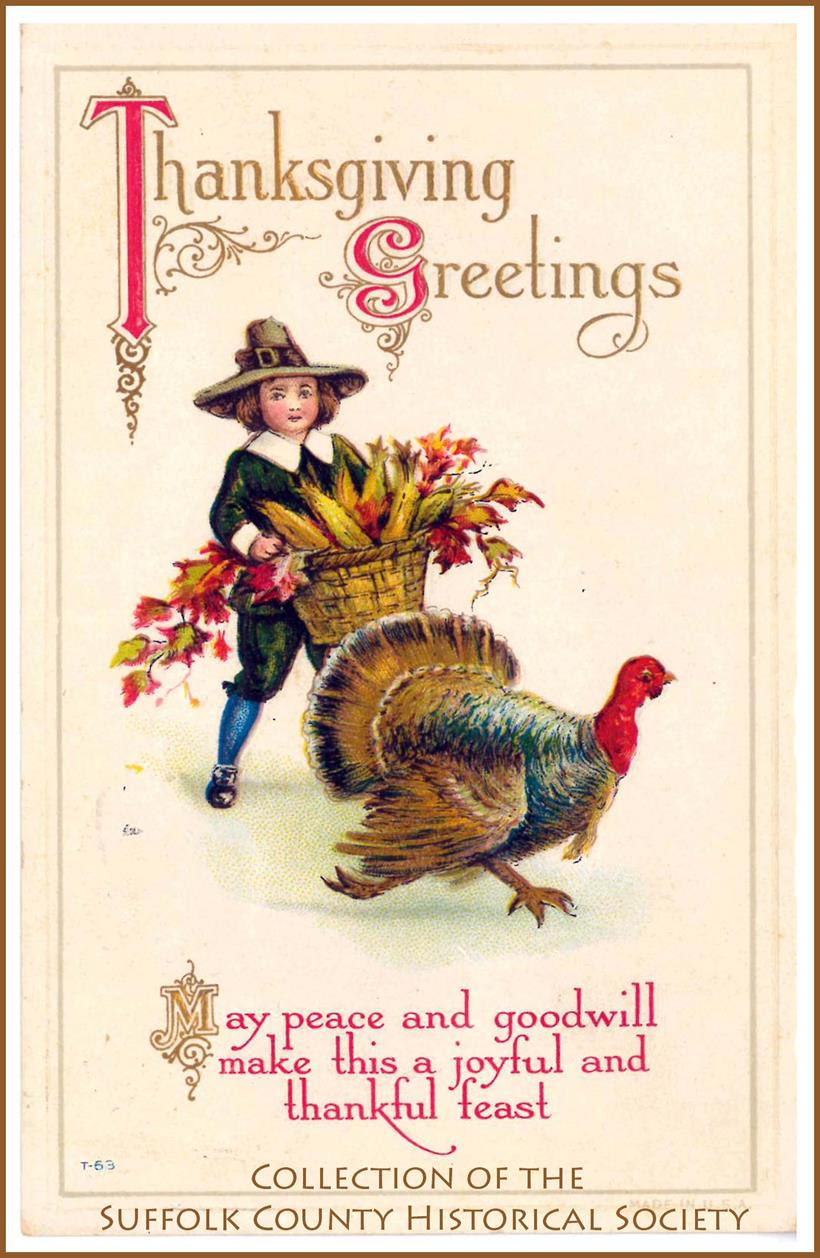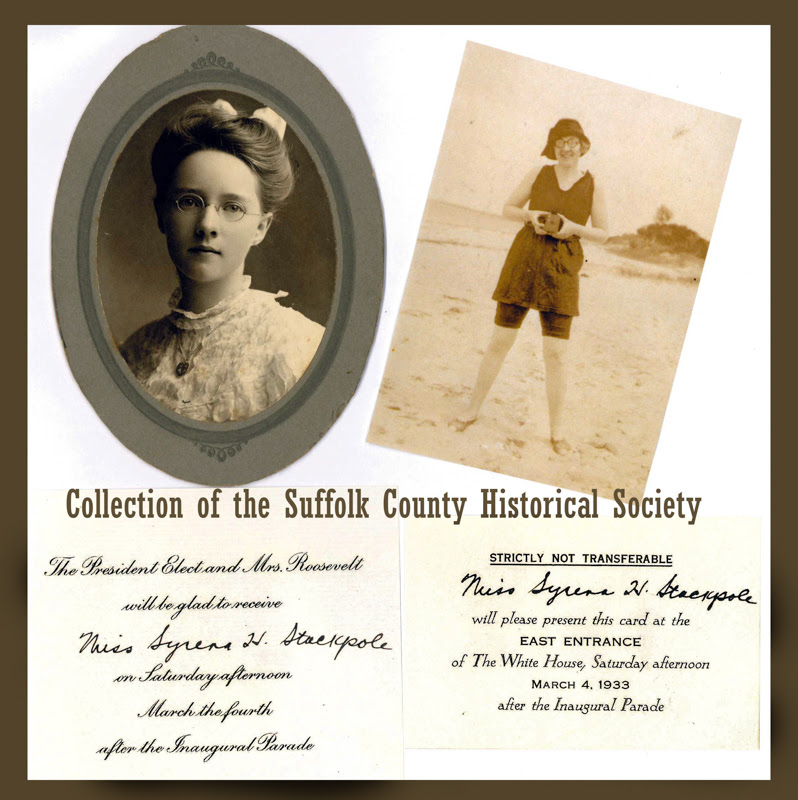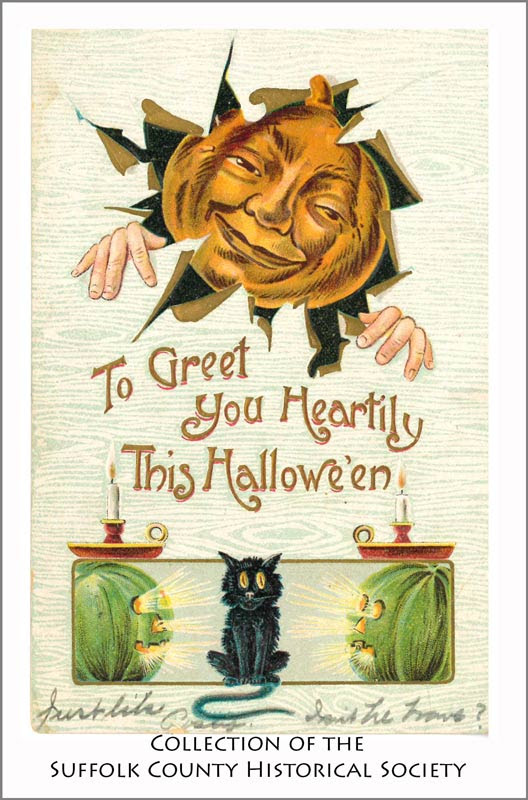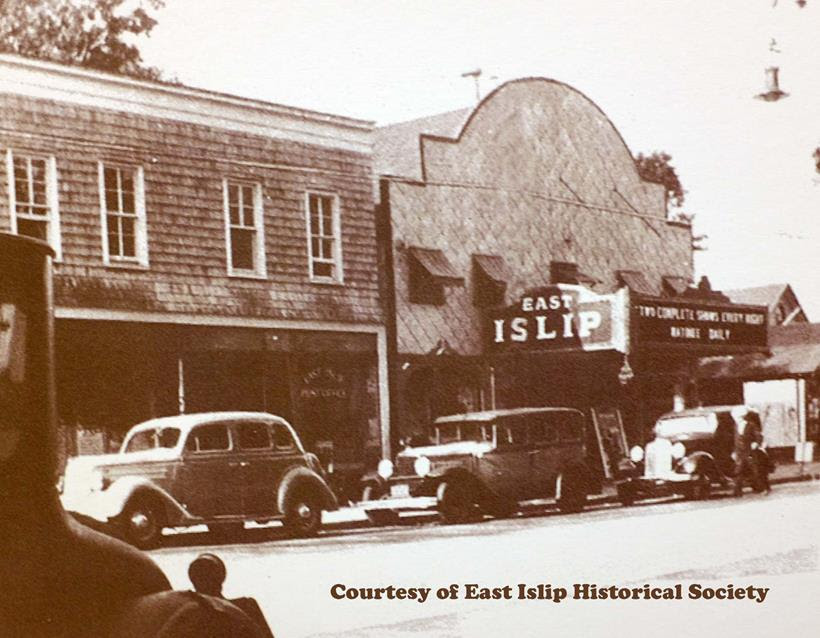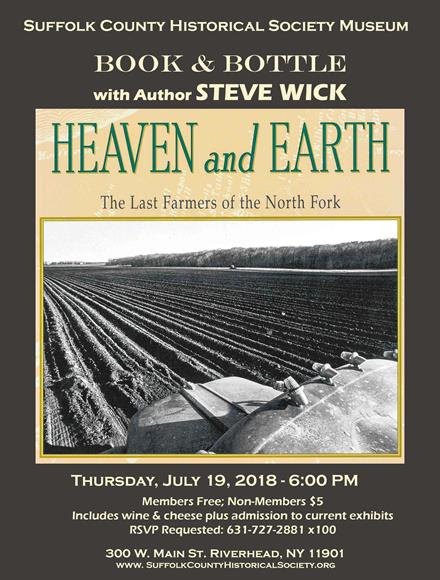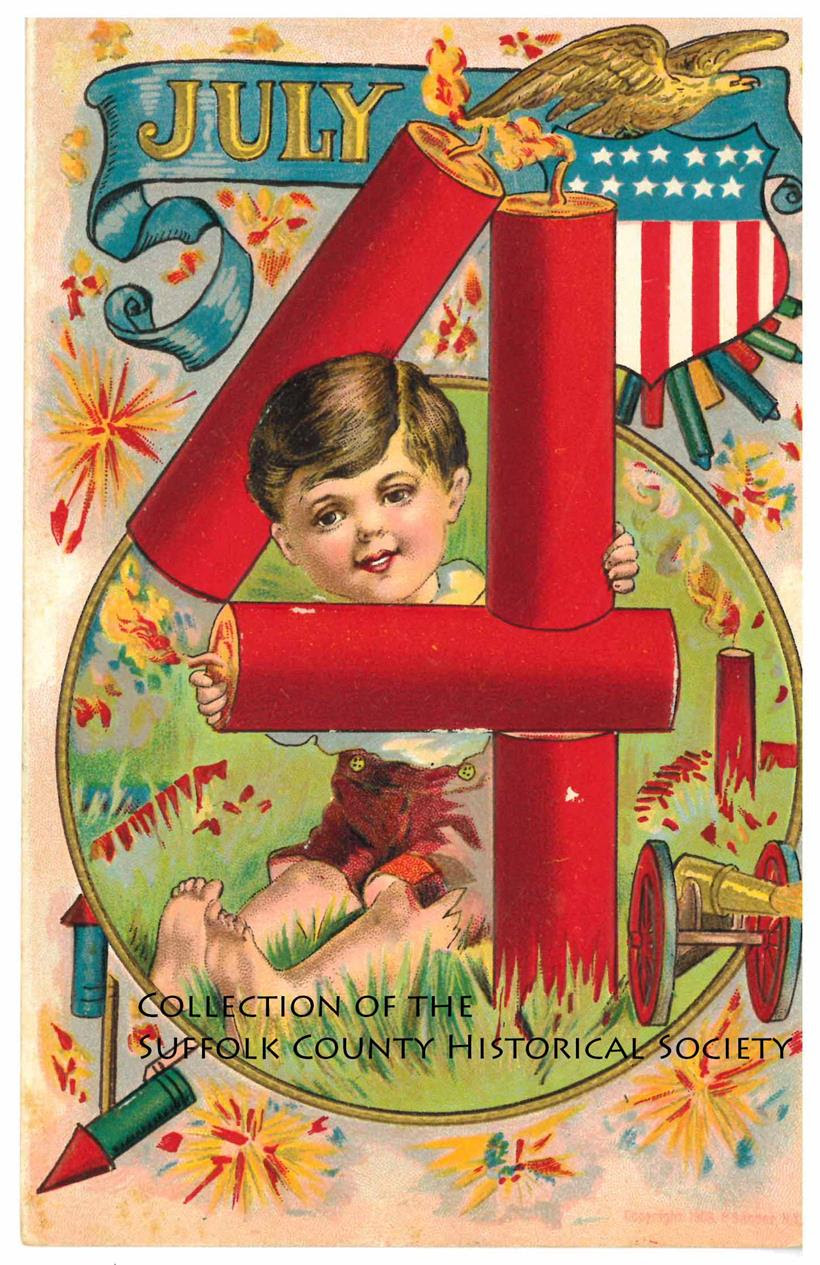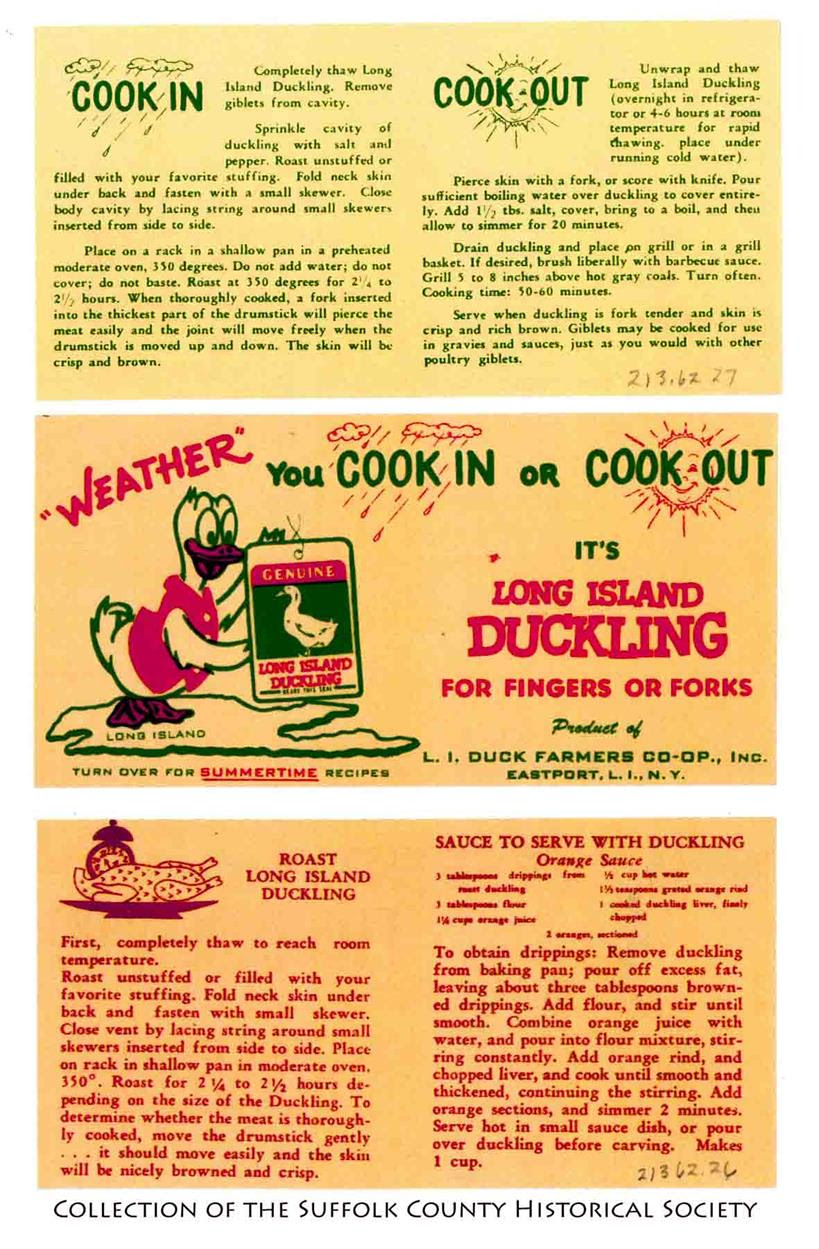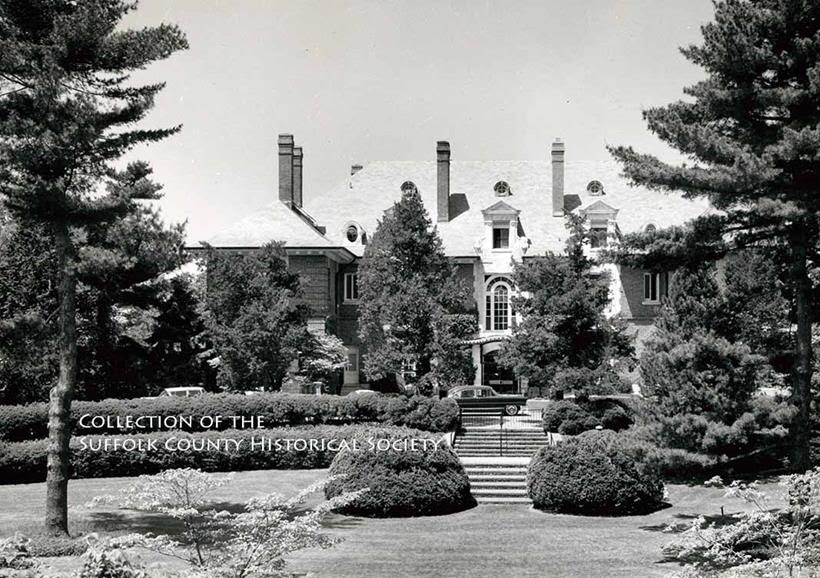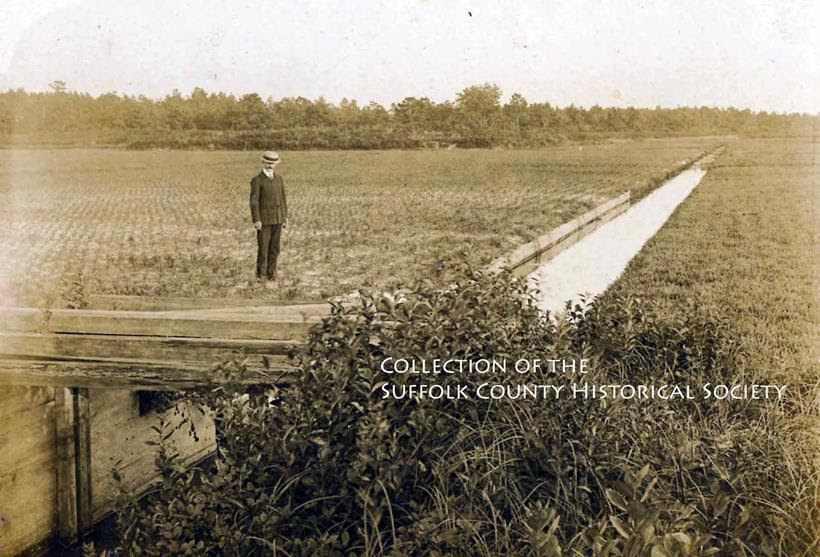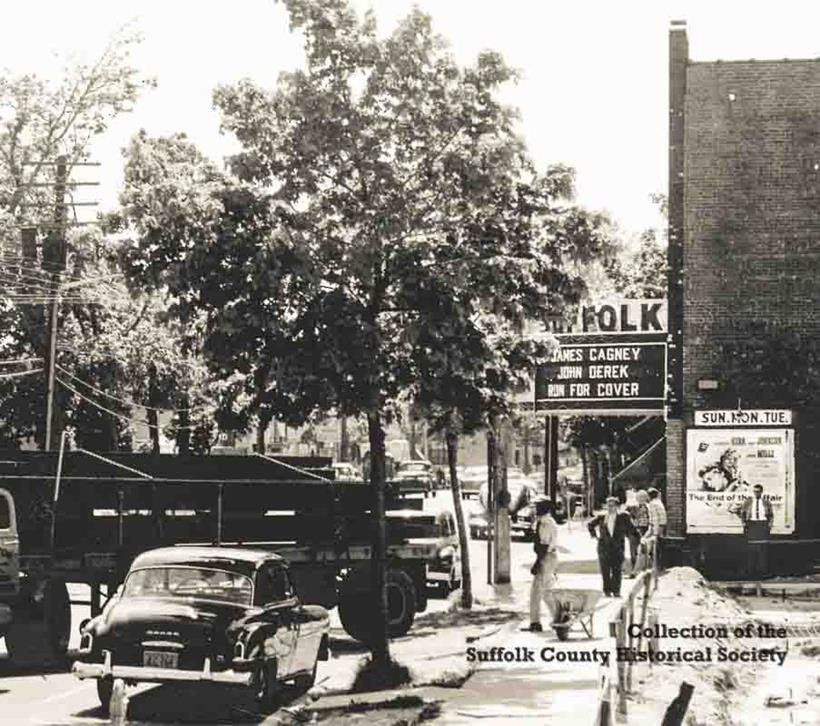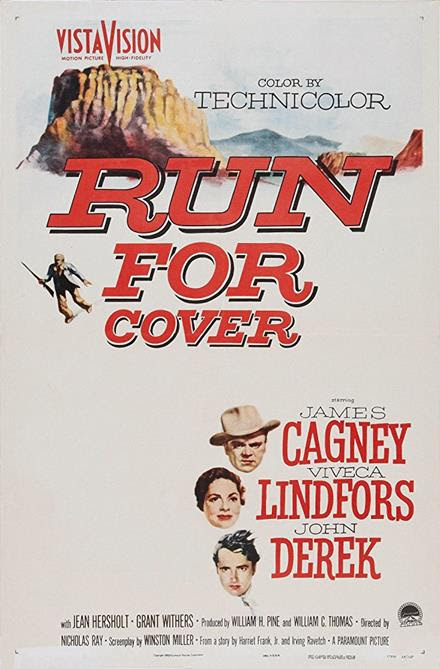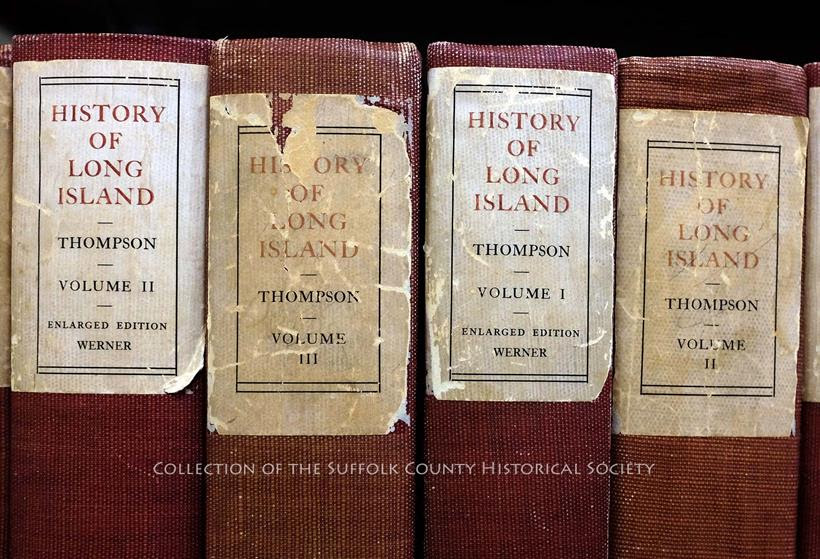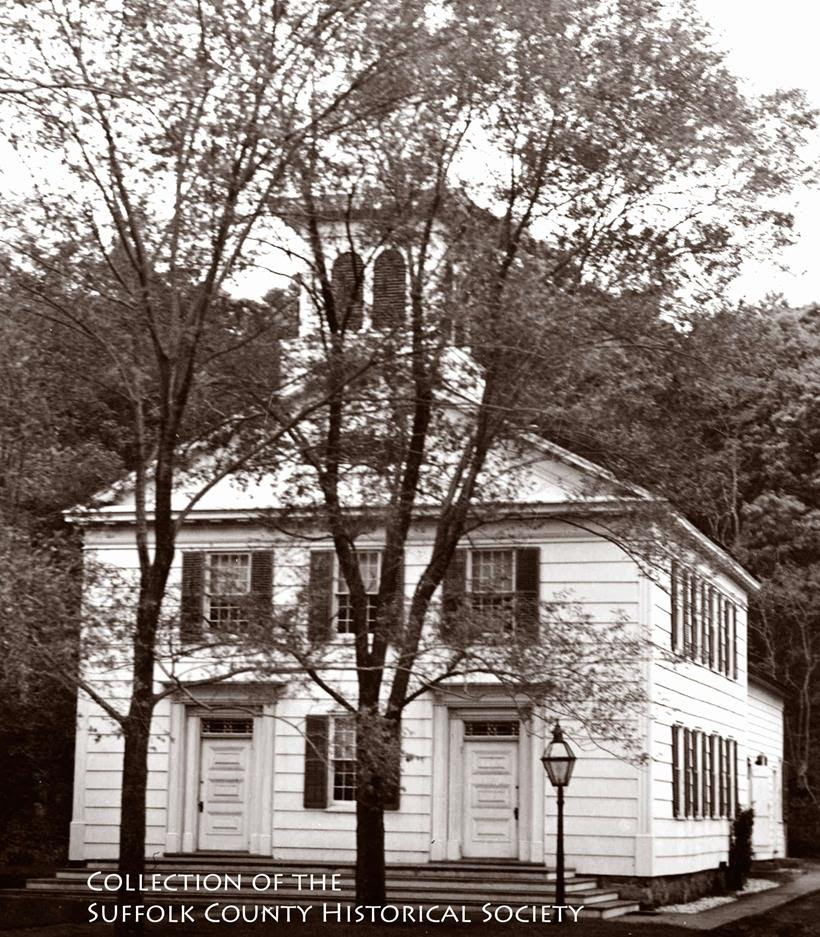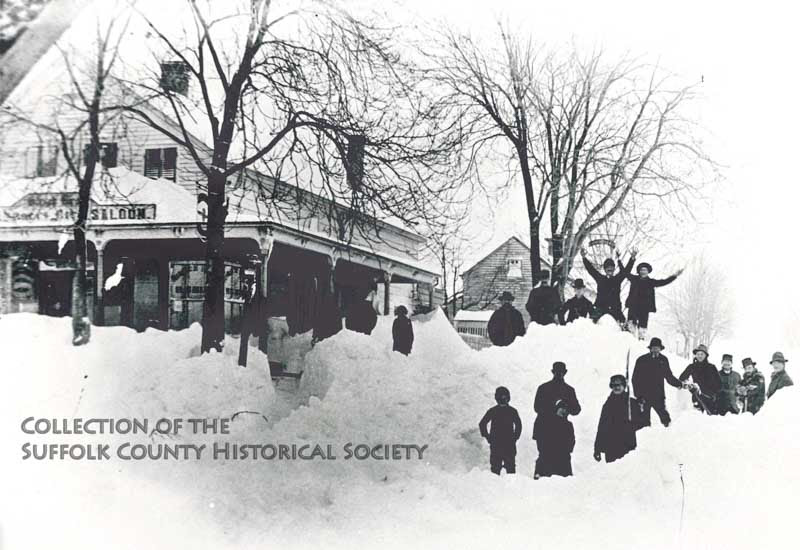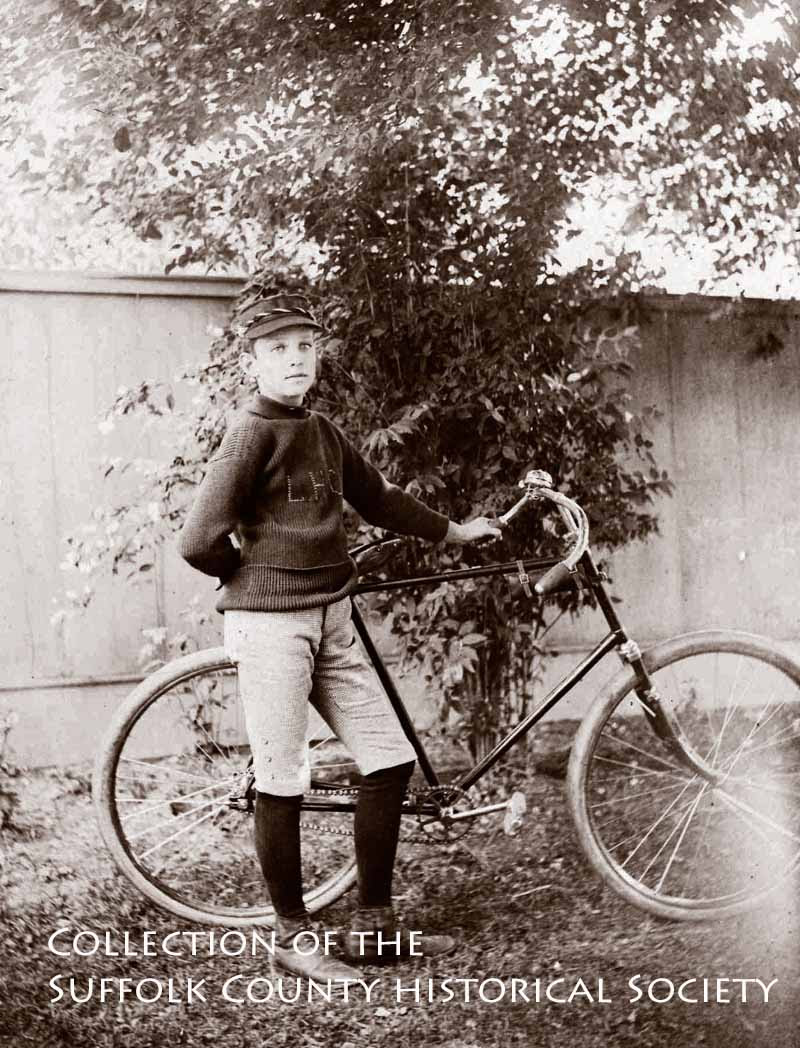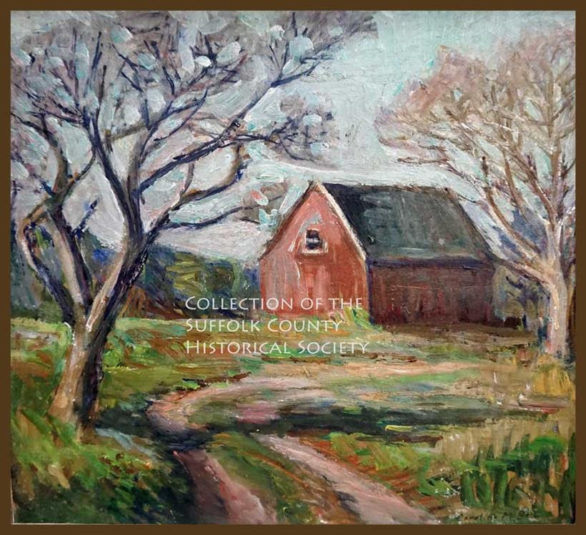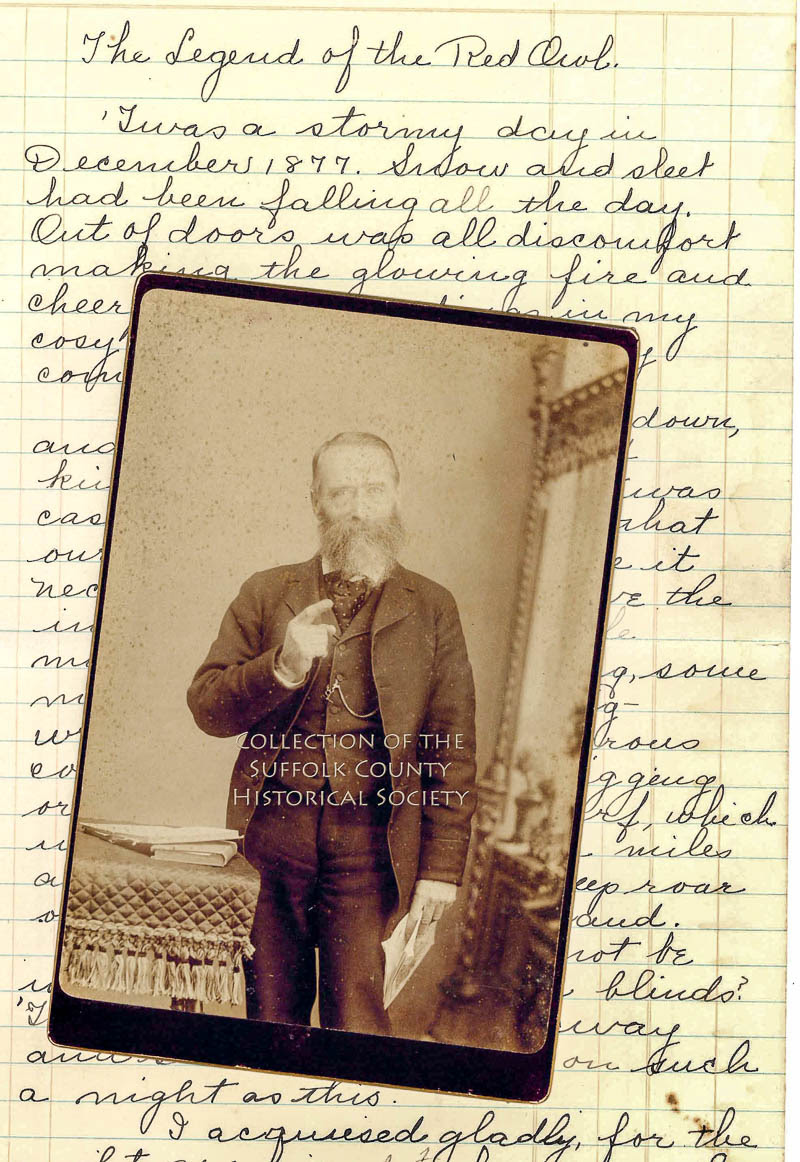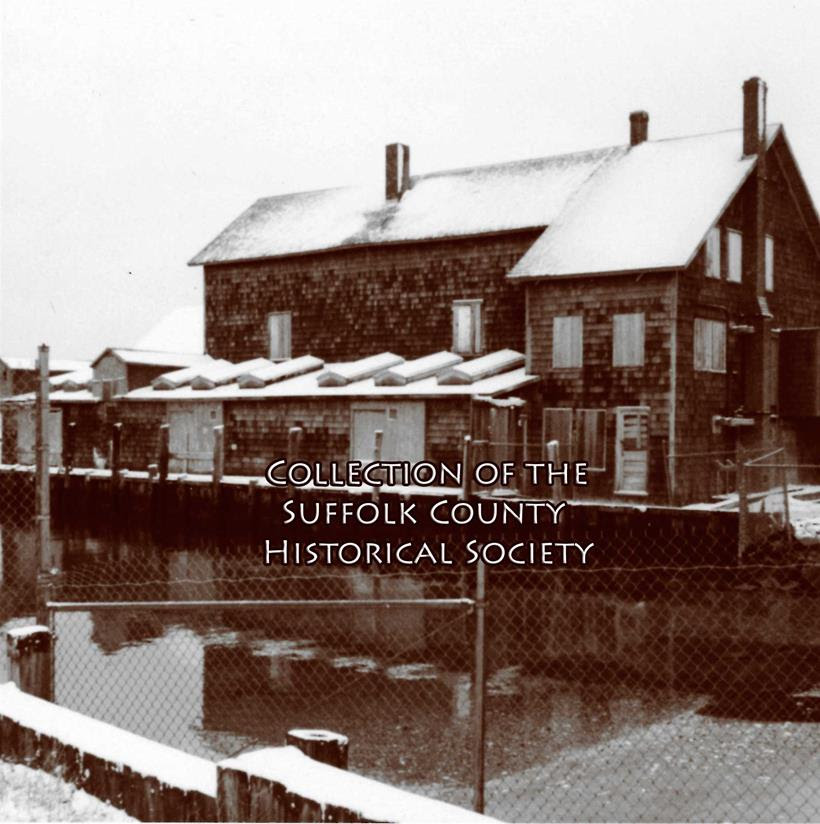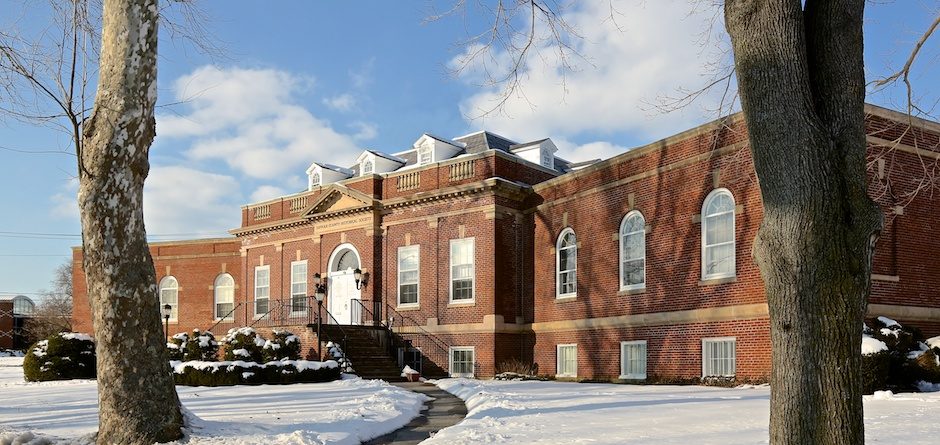
SUFFOLK COUNTY HISTORICAL SOCIETY
~~~~~~~~~~~~~~~~~~~~~~~~~~~~~~~~~~~~~
MEMBERSHIP DRIVE
If you’ve been enjoying our Photo of the Week, please consider becoming a member of SCHS. The Suffolk County Historical Society, founded in 1886, collects and preserves the rich history of Suffolk County and beyond. We offer a history museum, art galleries, a research library and archives, and a multitude of exhibits, programs, and educational lectures and workshops year-round. Our unique collections reflect more than three centuries of Long Island history.
From the Civil War to civil rights, revolutions to restorations, spies to Suffragettes, boatbuilders to bootleggers, and whalers to wineries, Long Island’s history comes alive at the Suffolk County Historical Society!
—————————————————–
The Suffolk County Historical Society’s PHOTO OF THE WEEK Series is created by head research librarian Wendy Polhemus-Annibell using historic primary source materials from our local history library’s extensive archives. To subscribe, visit our website or send an email request to Wendy at librarian@schs-museum.org
To view our Photo of the Week archives, visit our website at www.
——————–
Interested in seeing more historical photos from the Collection of the Suffolk County Historical Society? Spend an afternoon at our Local History Libraryperusing our extensive archival photography collections. We’re open Weds. – Sat., 12:30 – 4:30 PM.
___________________________________________
PHOTO OF THE WEEK: DECEMBER 21, 2018— FROM THE SCHS LIBRARY ARCHIVES
~~~~~~~~~~~~~~~~~~~~~~~~~~~~~~~~~~~~~~~~~~~

The Staff and Board of the
Suffolk County Historical Society
send warm wishes to all of our
friends and supporters
for a wonderful holiday season
and a very happy new year!
Holiday Closure: We will be closed December 26 – 29, and will reopen on Wednesday, January 2, 2019.
(Image from the Collection of the Suffolk County Historical Society Library Archives.)
******************************************
Visit: www.suffolkcountyhistoricalsociety.org
To View 2014 Photo of the Week pages click here.
To View 2015 Photo of the Week pages click here.
To View 2016 Photo of the Week pages click here.
To View 2017 Photo of the Week pages click here.
******************************************
PHOTO OF THE WEEK: DECEMBER 15, 2018— FROM THE SCHS LIBRARY ARCHIVES
“How shall we know it is us without our past?”
– John SteinbeckThe Orient Point Inn
by Wendy Polhemus-Annibell, Head Librarian
~~~~~~~~~~~~~~~~~~~~~~~~~~~~~~~~~~~~~~~~~~
The Orient Point Inn. (From the Collection of the Suffolk County Historical Society Library Archives. Images © copyright Suffolk County Historical Society. All rights reserved.)
At the eastern end of the North Fork, where the Long Island Sound merges with Gardiner’s Bay, across from the New London ferry, stood the Orient Point Inn–for almost two centuries. The oldest part of the structure dated back to 1672.
By 1776, after the Battle of Long Island, British troops occupied the property. In the 1800s, however, Jonathan Fish Latham enlarged the building and was the first to operate it as an inn. In its heyday, the facility brought crowds to the sun and sand of Orient Point. Children were welcome, and the inn advertised a beautiful garden, billiard room, livery stable, yachts, fishing boats, and swimming in the peaceful waters. The guests of the Orient Point Inn included President Grover Cleveland and Daniel Webster. James Fenimore Cooper reportedly wrote a chapter of The Sea Lions during a restful visit to the Inn, and Walt Whitman composed parts of Leaves of Grass there. Washington Irving’s and Sarah Bernhardt’s names were on the Inn’s register.
The inn had a series of owners and developed a reputation for fine dining and comfortable rooms for visitors. By 1938 the inn was still operating when the Long Island Express hurricane ripped off part of its roof. But by the 1950s and 1960s business had begun to suffer, and by the 1970s the building had been abandoned. Various plans for developing the property fell through. In 1984, the structure, which had deteriorated significantly, was demolished.
******************************************
Visit: www.suffolkcountyhistoricalsociety.org
To View 2014 Photo of the Week pages click here.
To View 2015 Photo of the Week pages click here.
To View 2016 Photo of the Week pages click here.
To View 2017 Photo of the Week pages click here.
******************************************
PHOTO OF THE WEEK: DECEMBER 8, 2018— FROM THE SCHS LIBRARY ARCHIVES
“How shall we know it is us without our past?”
– John SteinbeckSALISBURY COUNTRY CLUB, 1930
by Wendy Polhemus-Annibell, Head Librarian
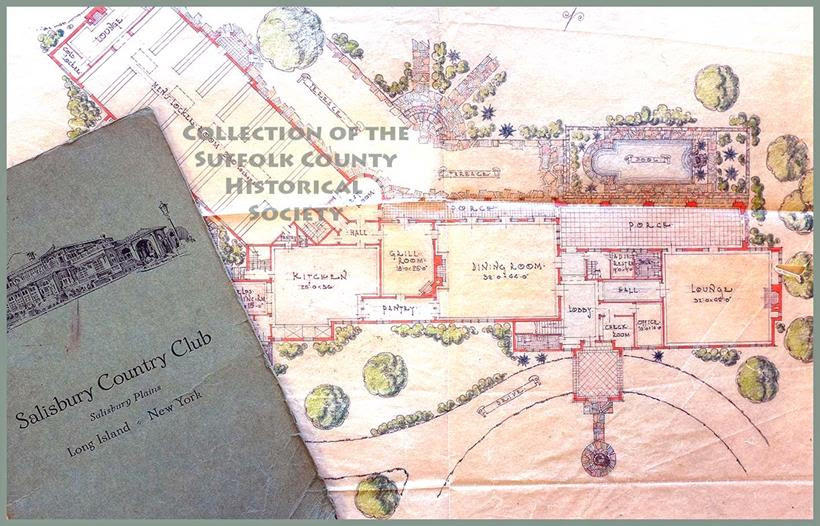
Pamphlet and Drawing of Salisbury Country Club, 1930. (From the Collection of the Suffolk County Historical Society Library Archives. Image © copyright Suffolk County Historical Society. All rights reserved.)
Salisbury Country Club in East Meadow was originally a private club with several 18-hole golf courses. First developed in 1917 by Joseph J. Lannin (owner of the Garden City Hotel, Roosevelt Airfield, and the Boston Red Sox), the golf club hosted the ninth PGA Championship in 1926, which was conducted on the present-day Red Course. The early Greens Fees were $100 annually, $30 monthly, or $10 weekly. Links 3 and 4 were reserved exclusively for members of the Salisbury Country Club. This original drawing of the “Proposed Golf Club at Salisbury Plains,” dated June 2, 1930, identifies J. A. McInnis as the builder and L. M. Bischoff as the architect.
During the Great Depression, the club’s owners were unable to pay property taxes and the county took over the property. In 1944, Nassau County Park at Salisbury was established, and in 1969 Salisbury Park was rededicated as Dwight D. Eisenhower Memorial Park at a ceremony attended by the thirty-forth president’s grandson, Dwight D. Eisenhower II.
******************************************
Visit: www.suffolkcountyhistoricalsociety.org
To View 2014 Photo of the Week pages click here.
To View 2015 Photo of the Week pages click here.
To View 2016 Photo of the Week pages click here.
To View 2017 Photo of the Week pages click here.
******************************************
PHOTO OF THE WEEK: DECEMBER 1, 2018— FROM THE SCHS LIBRARY ARCHIVES
“How shall we know it is us without our past?”
– John SteinbeckRiverhead Methodist Church Record Books
by Wendy Polhemus-Annibell, Head Librarian
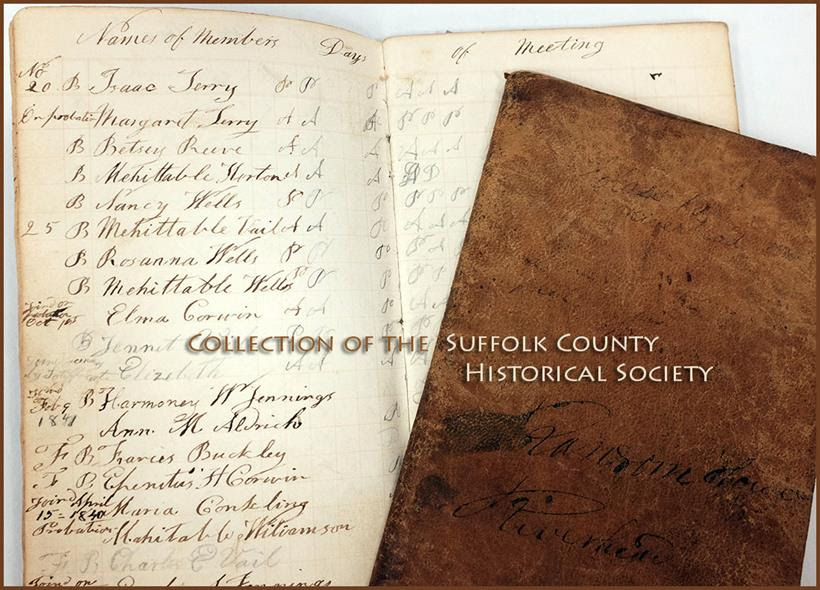
Riverhead Methodist Church Record Books, 1833-39 and 1840-47. (From the Collection of the Suffolk County Historical Society Library Archives. Copyright © Suffolk County Historical Society. All rights reserved.)
Beginning in about 1800, Methodist preachers visited Riverhead, and by 1825 some regular services were conducted by traveling preachers. During 1828-29, the Methodist and Congregational churches of Riverhead held services on alternate Sundays at the Riverhead Court House. By 1833, a church was organized with nine members who met at the home of Capt. John Vail. The following year the first Board of Trustees was formed, and a church building site on Main Street was purchased, on which a small church building was constructed and then dedicated in 1835. By 1869, the congregation decided to erect a new house of worship on Main Street. This new church building, completed in 1870, is the historic Riverhead United Methodist Church we see standing on Main Street today.
Our Riverhead Methodist Church record books, a relatively new acquistion to our library archive, date from the very early years of the church. Kept by Charles R. Howell, the record books begin with a listing of preachers (the first being Richard Wymond, in 1832) and continue with annual listings of members in 1833-39 and 1840-47. The nine members of the church organized in 1833 are listed as John Vail, Silas Vail, William Fisher, [illegible] Fisher, Elizabeth Osborne, Maria Perkins, Eliza Ann Berre, Joseph P. Hildreth, and Armenia Hildreth.Some of the member listings also include records of attendance at services.
******************************************
Visit: www.suffolkcountyhistoricalsociety.org
To View 2014 Photo of the Week pages click here.
To View 2015 Photo of the Week pages click here.
To View 2016 Photo of the Week pages click here.
To View 2017 Photo of the Week pages click here.
******************************************
PHOTO OF THE WEEK: NOVEMBER 17, 2018— FROM THE SCHS LIBRARY ARCHIVES
“How shall we know it is us without our past?”
– John SteinbeckThanksgiving Greetings
by Wendy Polhemus-Annibell, Head Librarian
The Suffolk County Historical Society’s staff and board send our warmest wishes to you and your family for a wonderful Thanksgiving holiday.
It was not until 1863 that Abraham Lincoln issued a presidential proclamation making Thanksgiving Day a national holiday. Before then Thanksgiving was celebrated at random, according to the whims of local town or state governments. Lincoln was no doubt persuaded, at least in part, by the relentless campaigning of Sarah J. Hale, editor of the nineteenth-century American women’s magazine Godey’s Lady’s Book, who pleaded with officials for over fifteen years for the nationalization of the holiday.
Holiday Closure: We will be closed November 22 – 24 for the Thanksgiving Holiday, and will reopen on Wednesday, November 28, 2018, at 10:00 a.m.
******************************************
Visit: www.suffolkcountyhistoricalsociety.org
To View 2014 Photo of the Week pages click here.
To View 2015 Photo of the Week pages click here.
To View 2016 Photo of the Week pages click here.
To View 2017 Photo of the Week pages click here.
******************************************
PHOTO OF THE WEEK: NOVEMBER 10, 2018— FROM THE SCHS LIBRARY ARCHIVES
“How shall we know it is us without our past?”
– John SteinbeckSyrena H. Stackpole, Justice of Peace, Riverhead, Elected 1931
by Wendy Polhemus-Annibell, Head Librarian
Syrena H. Stackpole (1888-1983). (Images from the Collection of the Suffolk County Historical Society Library Archives. Copyright © Suffolk County Historical Society. All rights reserved
This week’s Midterm Elections were a historic moment for women in the United States, particularly in the congressional elections, where an astounding 100 congresswomen were elected to the U.S. House of Representatives. Although Suffolk County has not ever elected a woman to serve as a member of Congress in either of its congressional districts, the Town of Riverhead has the distinction of electing the first woman to hold elected office–Syrena Stackpole–as Justice of the Peace, in 1931, when women had the right to vote for only 11 years.
Syrena H. Stackpole (1888-1983), the 1903 Riverhead High School valedictorian at age 14, was the daughter of attorney George Stackpole and suffragist Mary Stackpole of Riverhead. Earning her bachelor’s degree at Wellesley College (an award is still given by the college annually in her name), Syrena held various jobs for ten years after college–she “taught school, raised chickens and worked as a stenographer, librarian, and secretary”–before returning to school to earn her law degree at New York University School of Law. Ms. Stackpole became the first Suffolk County woman admitted to the New York State Bar and the first Suffolk County woman attorney to have her own law practice (which was based in Riverhead).
In another first, Syrena Stackpole was the first woman elected to public office as Justice of the Peace, in Riverhead Town in 1931, which at the time meant she was also a member of the town board. The Democratic State Committee, in a 1931 personal correspondence addressed to Ms. Stackpole, wrote: “The first time that a woman breaks into public office is a landmark in the progress of women, and you have blazed a trail for others to follow.” In recognition of Stackpole’s 1931 victory, fellow Democrat president-elect Franklin Delano Roosevelt, one year later, invited Syrena to the White House on the occasion of his inaugural parade. Stackpole, who was 42 years old at the time of her historic election, continued to practice law in Riverhead until her early 90s.
~~~~~~~~~~~~~~~

WOODEN WONDERLAND
Holiday Craft Show & Sale
DECEMBER 1 10:00 am – 4:30 pm
Free Admission for the Whole Family
******************************************
Visit: www.suffolkcountyhistoricalsociety.org
To View 2014 Photo of the Week pages click here.
To View 2015 Photo of the Week pages click here.
To View 2016 Photo of the Week pages click here.
To View 2017 Photo of the Week pages click here.
******************************************
PHOTO OF THE WEEK: NOVEMBER 3, 2018— FROM THE SCHS LIBRARY ARCHIVES
“How shall we know it is us without our past?”
– John SteinbeckIrving Berlin at Camp Upton, Yaphank
by Wendy Polhemus-Annibell, Head Librarian
War Department Theatre at Camp Upton, Yaphank, c. 1917. (Image from the Collection of the Suffolk County Historical Society Library Archives. Copyright © Suffolk County Historical Society. All rights reserved.)
Born in Russia in 1888, Irving Berlin was a well-known American songwriter of “God Bless America,” “White Christmas,” and nineteen Broadway musicals. Berlin was also a soldier at Camp Upton in Yaphank and a sergeant in the 77th Infantry Division during World War I. When he was five years old, Berlin and his family were fleeing Russian persecution of Jews when they came to the United States in 1893, settling into an immigrant tenement neighborhood in New York City. By age nineteen, Berlin was working as a singing waiter in NYC’s Chinatown, and in 1911 his song “Alexander’s Ragtime Band” was an international hit.
After becoming an American citizen in 1918 and being drafted into the Army, Irving Berlin was stationed at Camp Upton. He hated getting up in the morning when the bugle blew at the camp, so he wrote the song “Oh! How I Hate to Get Up in the Morning” (you can listen to it here). That song was one of several Berlin wrote for his 1918 production of the musical comedy Yip Yip Yaphank, composed while he was stationed at Camp Upton. Performed by an all-male cast of soldiers, the musical revue made its way to Broadway and raised $150,000 for improvements at the camp. Though Berlin had originally composed “God Bless America” as the final number for Yip Yip Yaphank, he decided instead to substitute “We’re on Our Way to France” to honor the men on their way to war.
————-
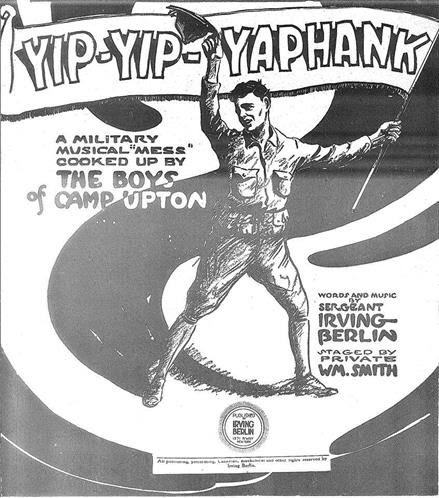
On the 100th anniversary of Armistice Day, Longwood High School students will bring Irving Berlin’s Yip Yip Yaphank to the stage at the high school located at 100 Longwood Road in Middle Island. The performances are free to the public, and will take place on Friday, November 9, at 7:00 pm and on Saturday, November 10, at 2:00 pm and 7:00 pm. Call 631-345-2960 for more information.
******************************************
Visit: www.suffolkcountyhistoricalsociety.org
To View 2014 Photo of the Week pages click here.
To View 2015 Photo of the Week pages click here.
To View 2016 Photo of the Week pages click here.
To View 2017 Photo of the Week pages click here.
******************************************
PHOTO OF THE WEEK: OCTOBER 27, 2018— FROM THE SCHS LIBRARY ARCHIVES
“How shall we know it is us without our past?”
– John SteinbeckSome 19th Century Executions at Riverhead
by Wendy Polhemus-Annibell, Head Librarian
Halloween Greeting from the Past. (From the Collection of the Suffolk County Historical Society Library Archives.)
Some 19th-Century Executions at Riverhead
When Halloween right around the corner, we thought it fitting to highlight a bit of Suffolk County’s gruesome past: the executions that took place in nineteenth-century Riverhead. Before the Suffolk County Court House and jail were built in Riverhead in 1855, public hangings of convicted murderers were held in the courtyard of the old county jail on Main Street. The old gallows had been constructed of native oak in the early 1830s in anticipation of the execution of William Enoch in 1835. The last hanging in the county took place in 1888, in the new jail courtyard. The convicted man was Francis Asbury Hawkins.
1835 – William Enoch, age 60, gunned down his wife at Crab Meadow Beach in Northport because, he said, he was “in a bad mood.” He was executed in Riverhead on January 16, 1835.
1836 – John Hallock, an “obnoxious drunk” who pulled out a knife and stabbed a black woman named Nell “so that her innards came out,” was executed at Riverhead on July 2, 1836.
1841 – Samuel Johnson, who shot his wife in front of their children, was executed at Riverhead on July 6, 1841.
1844 – Antoine Geissler, a German drifter, battered to death an elderly Smith couple at their home in Huntington, and then looted the premises and set the place on fire. He was caught wearing Smith’s boots, and was executed at Riverhead on June 7, 1844.
1854 – Nicholas Behan, age 20, having a grudge against his ex-boss, James Wickham of Cutchogue, crept into the man’s house with an ax and hacked Mr. and Mrs. Wickham to death in their bed. Behan was executed at Riverhead on December 15, 1854.
1888 – Francis Ashbury Hawkins, age 23, from one of Suffolk County’s well-to-do families, had settled his fancies on a humble waitress, much to the disdain of his mother. Being obliged to marry the pregnant woman as soon as possible, he asked his mother to accept her into their family. Mrs. Hawkins refused to consider the matter and threatened to disinherit her son if he married “that wench.” While on a buggy ride along Awixa Avenue in Islip, the young man made one last attempt to talk his mother into accepting the young woman. Once again she refused, so Francis pulled out a gun and shot his mother point blank in the face. He was executed at Riverhead on December 11, 1888.
Suggested Reading: Legal Executions in New York State, by Daniel Allen Hearn.
******************************************
Visit: www.suffolkcountyhistoricalsociety.org
To View 2014 Photo of the Week pages click here.
To View 2015 Photo of the Week pages click here.
To View 2016 Photo of the Week pages click here.
To View 2017 Photo of the Week pages click here.
******************************************
PHOTO OF THE WEEK: OCTOBER 20, 2018— FROM THE SCHS LIBRARY ARCHIVES
“How shall we know it is us without our past?”
– John SteinbeckWorld War I Centennial
by Wendy Polhemus-Annibell, Head Librarian
Journal of the Suffolk County Historical Society. (Image from the Collection of the Suffolk County Historical Society Library Archives.)
The Journal of the Suffolk County Historical Society is published annually by the Suffolk County Historical Society. Launched on June 8, 1975 as an 8-page pamphlet titled the Register, the quarterly publication was, for about 40 years, dedicated almost exclusively to Long Island genealogy. Since then, the Journal (retitled in 2016) has evolved into a mixed-topic or theme-based publication incorporating historical and/or genealogical articles and illustrations related to Long Island’s past–its places, people, and events.
Our 2018 Journal of the Suffolk County Historical Society, to be released next month, is chock-full of engaging articles commemorating the centennial of World War One and the Long Island experience during the war. The centennial of the U.S. involvement in the war inspired the Suffolk County Historical Society in 2017 to mount a major exhibit, Over Here, Over There: Long Island and the Great War, and to host a symposium that resulted in the series of papers contained in this year’s Journal issue.
The Journal of the Suffolk County Historical Society is a free publication available only to Society members. A limited number of copies will be available to SCHS members. If you are not an SCHS member, be sure to become a member before the end of 2018 to receive your own copy of the World War One Centennial issue of our Journal. Visit our Member page for more information:
http://www.suffolkcountyhistoricalsociety.org/membership.html
******************************************
Visit: www.suffolkcountyhistoricalsociety.org
To View 2014 Photo of the Week pages click here.
To View 2015 Photo of the Week pages click here.
To View 2016 Photo of the Week pages click here.
To View 2017 Photo of the Week pages click here.
******************************************
PHOTO OF THE WEEK: OCTOBER 13, 2018— FROM THE SCHS LIBRARY ARCHIVES
“How shall we know it is us without our past?”
– John Steinbeck
USS San Diego, Sinks Off Fire Island, 1918
by Wendy Polhemus-Annibell, Head Librarian
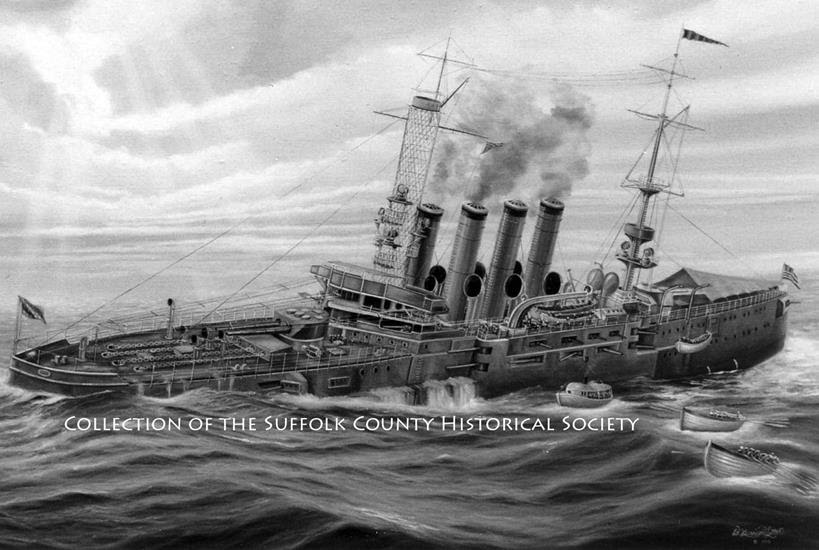
July 19, 1918: After colliding with a mine laid by a German U-boat, the heavy-armored USS San Diego began to list to port and settle. Twenty-eight minutes later, the warship completely capsized and sank stern first in 110 feet of water, just eight miles off Fire Island. Captain Harley Christy was the last man to leave the sinking ship. Six American sailors lost their lives.
The USS San Diego was the only major U.S. warship lost in World War I. Originally named USS California, the ship was renamed San Diego in 1914 to bring the U.S. Navy into compliance with a policy of the time to reserve state names for battleships. The ship became part of the 2nd Division of the Pacific Fleet and mostly operated along the West Coast, until it was ordered to the Atlantic Fleet in 1918, where it was based in Tompkinsville, NY, and Halifax, Nova Scotia. Its mission was to escort convoys through the weather-torn and submarine-infested North Atlantic along their first passages to Europe. On its last journey of July 19, 1918, the USS San Diego was bound from Portsmouth, N.H., to New York City when it sank off the coast of Fire Island.
—————————–

Join us for a Book & Bottle author talk with Richard F. Welch on Long Island & World War I on Thursday, November 8, 2018 at 6:00 pm.
Call 631-727-2881 x100 to reserve.
******************************************
Visit: www.suffolkcountyhistoricalsociety.org
To View 2014 Photo of the Week pages click here.
To View 2015 Photo of the Week pages click here.
To View 2016 Photo of the Week pages click here.
To View 2017 Photo of the Week pages click here.
******************************************
PHOTO OF THE WEEK: OCTOBER 6, 2018— FROM THE SCHS LIBRARY ARCHIVES
“How shall we know it is us without our past?”
– John Steinbeck
WASHINGTON ENGINE CO. No. 2, Riverhead, 1930
by Wendy Polhemus-Annibell, Head Librarian
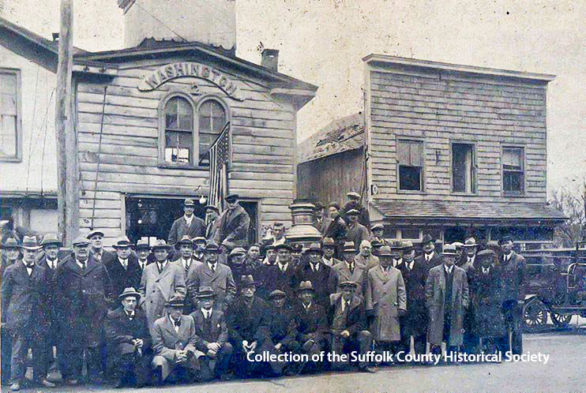
Washington Engine Co. No. 2, Riverhead, 1930. (Image from the Collection of the Suffolk County Historical Society Library Archives. Copyright © Suffolk County Historical Society. All rights reserved.)
The Washington Engine Co. No. 2, the oldest company in the Riverhead Fire Department, was founded in 1861. Officials of the town of Riverhead appointed the first officials of the fire company, it being the custom at the time for the supervisor or the justices to make such appointments. Among those appointed were Oliver A. Terry, who served many years as fire chief; David F. Vail, the company’s first foreman; and J. Henry Perkins, a prominent local businessman. The first meetings of the Washington company were held in the old Riverhead Court House.
The men in this 1930 photograph were all members of the Washington company at some point in their lives. They were gathered for their last meeting at the company’s old building on the east side of Peconic Avenue, which was to be torn down to make the roadway wider. Later that day the company entertained its present and former members at a dinner of roasted duck and chicken.
Pictured in the group, left to right: Front row: Arthur J. Fisher, former Chief F. Carll Hallett, O. B. Foley, George T. Reeve. A. J. Schaefer, Charles S. Elton, Vernon F. Corwin. Back row: John R. Hogan, Charles Y. Gardiner, Charles H. Hempstead, Fred F. Marrin, Ellsworth O. Benjamin, Ulick Bell, Everett B. Sweezy, J. Harry Brown, Fred S. Hill, Christopher J. Schmersal, W. A. Fisher, G. Homan, Orville R. Young, Ellis S. Duvall, T. F. Hutchings, Chris Hempstead, Kirk Bagshaw, George K. Morell, Charles L. Corwin, George W. Hildreth, William A. Terry, William H. Clark, Edward W. Carter, Russell T. Smith, Nelson Hulse, Neil H. Larsen. On the engine: Chief Carl F. Peterson, Charles H. Weller, former Chief Nathan T. Corwin, Philip Worm, J. I. Edwards, Charles Diamond, Elliot Young, Andrew Brodski, Caldwell Worm.
******************************************
Visit: www.suffolkcountyhistoricalsociety.org
To View 2014 Photo of the Week pages click here.
To View 2015 Photo of the Week pages click here.
To View 2016 Photo of the Week pages click here.
To View 2017 Photo of the Week pages click here.
******************************************
PHOTO OF THE WEEK: SEPTEMBER 28, 2018— FROM THE SCHS LIBRARY ARCHIVES
“How shall we know it is us without our past?”
– John SteinbeckDERING HARBOR, Shelter Island
by Wendy Polhemus-Annibell, Head Librarian
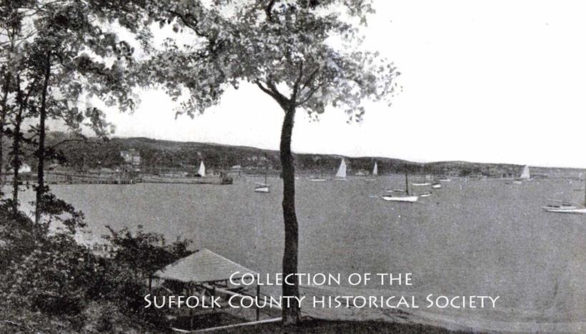
Dering Harbor, Shelter Island. (Image from the Collection of the Suffolk County Historical Society Library Archives. Copyright © Suffolk County Historical Society. All rights reserved.)
Dering Harbor, an incorporated village in the Town of Shelter Island, is located on the north side of the island, facing Greenport. According to the 2010 census, the village population was 11, making it the least populated village in the state of New York. At 200 acres in size, Dering Harbor is also claimed to be one of the smallest incorporated villages.
The Dering Harbor community was formed in 1916 from where the Manhanset House hotel had stood from 1874 to 1910. The sprawling 300-room resort was destroyed by fire in the spring of 1910. Both the village and the harbor that separates it from Shelter Island Heights were named after Thomas Dering, a Boston merchant who in 1756 had married Mary Sylvester of Shelter Island’s founding family. Dering became the town’s second supervisor as well as a member of the new U.S. Congress. He was also a member of the convention that created New York’s first constitution.
Suggested Reading: “The Smallest Village: The Story of Dering Harbor” by Stewart W. Herman (1976).
~~~~~~~~~~~~~~~~~~~~~
Silver Screens Silent Film Program:
Lecture, Silent Film, and Musical Accompaniment by Long Island composer J. K. Hodge
————–
Saturday, September 29, 2018 ~ 1:00 – 3:30 pm
RSVP & Prepayment Required: 631-727-2881 x100
Members $15; Non-Members $20
Refreshments, beverages, and popcorn will be served at this family-friendly event.Join us for a special lecture, film, and musical program focused on the nostalgia of the silent film era. This special event will begin with a lecture on the early history of silent film, followed by the live experience of two original silent films with musical accompaniment scored and performed live by composer J. K. Hodge. Be sure to allow additional time to enjoy our Silver Screens of Suffolk exhibition, featured in our grand Staas Gallery. Space is limited! Call to reserve today! 631-727-2881 x100
******************************************
Visit: www.suffolkcountyhistoricalsociety.org
To View 2014 Photo of the Week pages click here.
To View 2015 Photo of the Week pages click here.
To View 2016 Photo of the Week pages click here.
To View 2017 Photo of the Week pages click here.
******************************************
PHOTO OF THE WEEK: SEPTEMBER 22, 2018— FROM THE SCHS LIBRARY ARCHIVES
“How shall we know it is us without our past?”
– John SteinbeckEAST ISLIP THEATER
by Wendy Polhemus-Annibell, Head Librarian
East Islip Theater, 1935-1981. (Image courtesy of the East Islip Historical Society.)
After enjoying a 20-year career in theater management, in the 1930s Long Island resident James Poro was ready to try his hand at theater ownership. He moved his family to East Islip, and in 1935 opened a theater there. Popular with the local community, the East Islip Theater was still owned by Poro when he retired at age 88. Honored for being the oldest living member of the Motion Picture Pioneers, a national organization, Poro was widely respected for refusing to sell his theater in East Islip to the large corporate syndicates that had come to dominate the industry. He did eventually sell the theater, but not until 1978, and in 1981, it was lost to fire.
In the early years of silent film, Suffolk County was a sought-after scenic setting for scores of films given its beautiful coastal light, sweeping sandy beaches, and lush local estates. Montauk, the Hamptons, and Sayville were well-known film locations where local residents found regular employment as “extras” for five or ten dollars a day, and local production studios like Vitagraph based in Bay Shore generated reel after reel of entertainment. Long Islanders watched in awe as their early vaudeville theaters were converted to silver screens. Though Hollywood would eventually eclipse the East Coast film industry by the 1930s, from the late nineteenth century through the first few decades of the twentieth, Long Island supported a thriving local film production industry from Brooklyn to Bay Shore.
Come experience the magic of Long Island’s silent film era at our special Silver Screens program next weekend, Saturday, September 29, 1:00 pm. Long Island composer J.K. Hodge will show a silent film and perform the live music just as it was done a hundred years ago!
******************************************
Visit: www.suffolkcountyhistoricalsociety.org
To View 2014 Photo of the Week pages click here.
To View 2015 Photo of the Week pages click here.
To View 2016 Photo of the Week pages click here.
To View 2017 Photo of the Week pages click here.
******************************************
PHOTO OF THE WEEK: SEPTEMBER 15, 2018— FROM THE SCHS LIBRARY ARCHIVES
“How shall we know it is us without our past?”
– John Steinbeck
The Grathwohl Collection
by Wendy Polhemus-Annibell, Head Librarian
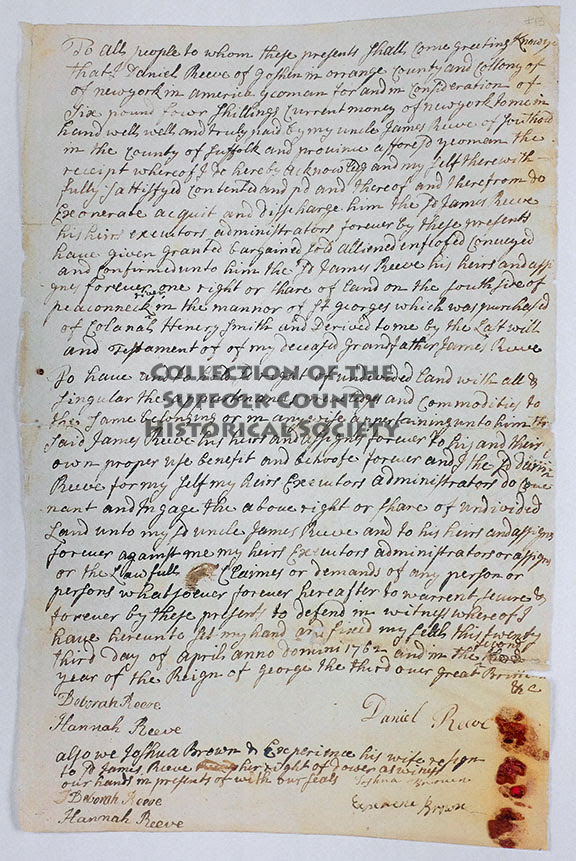
The Grathwohl Collection. (Image from the Collection of the Suffolk County Historical Society Library Archives. Copyright © Suffolk County Historical Society. All rights reserved.)
The year 2018 marked the completion of one of the Suffolk County Historical Society’s most ambitious conservation efforts to date: the Grathwohl Collection, a series of Suffolk County documents dating from 1676 to 1827. Received in very poor and fragile condition, the documents required $18,000 in conservation treatments by the Conservation Center for Art and Historic Artifacts in Philadelphia. Through generous grants provided by the New York State Department of Education and the Moore Charitable Foundation, all forty-seven rare and valuable documents in the collection have been preserved. The collection is now available to the public for research in our library archives.
Donated to the Society by Jim Grathwohl, a Cutchogue native and Southold history preservationist, the collection documents the people, events, lifestyle, and property ownership of the early east end of Long Island, with a focus on the North Fork. These historic treasures include, among many others, the 1671 last will and testament of William Purrier of Southold; a 1712 bill of sale from Thomas Turrill of Southold for four acres of land in Mattituck, witnessed by Joshua Horton Jr. and Justice Benjamin Youngs; a 1789 deed between John Corwin and John Reeve of Southold for a meadow near Gardiner’s Creek in Southold; an 1816 bill of sale for Robbins Island (375 acres) for $500; the 1797 manumission by Jonathan Jagger of Southampton of a thirty-year-old female slave named Pegg and her one-year-old child Tamer; and letters from Anna Harrison, wife of U.S. President William Henry Harrison, to her cousins in Southold.
This collection features not only the original copies of the documents; in many cases, they are also the only known copy of otherwise unrecorded events. Come take a look! Our research library and archive is open Wednesday through Saturday, 12:30 pm to 4:30 pm. No appointment is necessary.
******************************************
Visit: www.suffolkcountyhistoricalsociety.org
To View 2014 Photo of the Week pages click here.
To View 2015 Photo of the Week pages click here.
To View 2016 Photo of the Week pages click here.
To View 2017 Photo of the Week pages click here.
******************************************
PHOTO OF THE WEEK: SEPTEMBER 8, 2018— FROM THE SCHS LIBRARY ARCHIVES
“How shall we know it is us without our past?”
– John Steinbeck
The Great Atlantic & Pacific Tea Company
by Wendy Polhemus-Annibell, Head Librarian
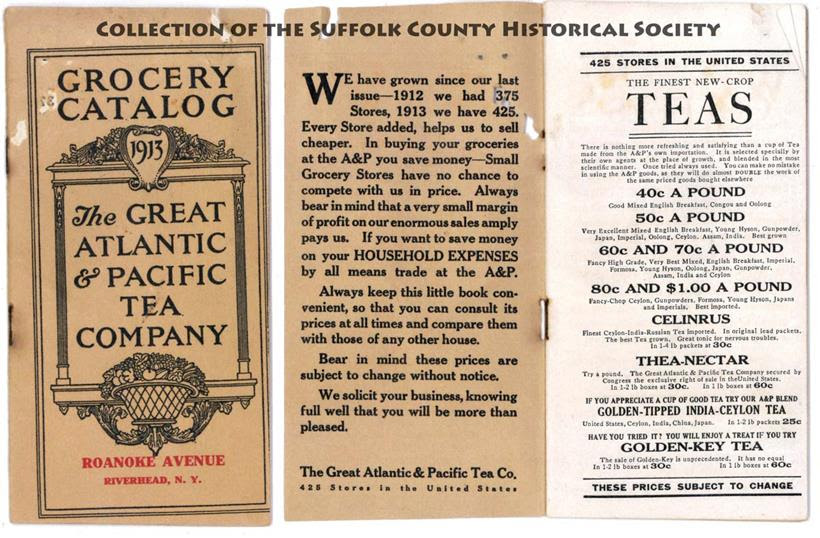
A&P Grocery Catalog, Roanoke Ave., Riverhead Store, 1913. (Images from the Collection of the Suffolk County Historical Society Library Archives. Copyright © Suffolk County Historical Society. All rights reserved.)
The Great Atlantic & Pacific Tea Company, more commonly known as A&P, was a U.S. grocery store chain founded in 1859 in New York City that grew to operate stores throughout the country for over 150 years (until 2015). A&P had 425 stores in America in 1913, according to this grocery catalog from our collection. By 1925, however, the chain was operating more than thirteen thousand grocery stores nationwide and employing over forty thousand people.
A&P was a place where most Americans in the modern era grew up shopping. It was able to gain a popularity with consumers that few companies have ever achieved in the United States. No doubt offering a detailed grocery catalog of offerings at fair prices was one of the keys to the company’s long-term success. Here are a few selected examples pulled from the catalog: Kellogg’s Corn Flakes – 10 cents; Maple Syrup, 1 gallon – $1.50; Strawberry Jam, 1 pound – 15 cents; Castile soap – 5 cents a bar; and the popular Eight O’Clock Coffee beans – 25 cents per pound.
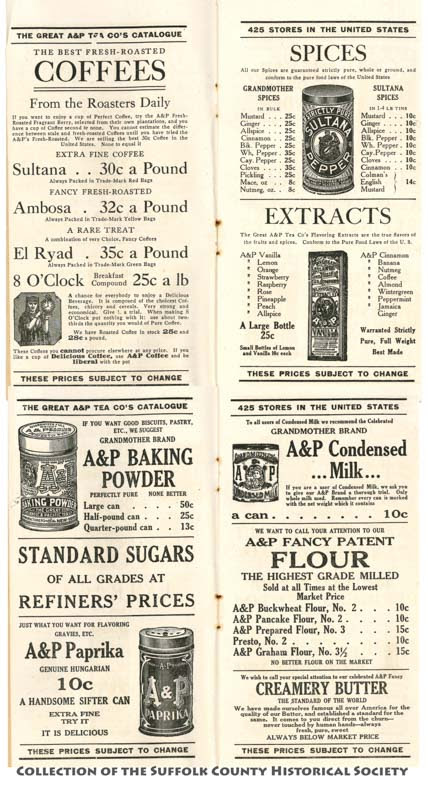
******************************************
Visit: www.suffolkcountyhistoricalsociety.org
To View 2014 Photo of the Week pages click here.
To View 2015 Photo of the Week pages click here.
To View 2016 Photo of the Week pages click here.
To View 2017 Photo of the Week pages click here.
******************************************
PHOTO OF THE WEEK: SEPTEMBER 1, 2018— FROM THE SCHS LIBRARY ARCHIVES
“How shall we know it is us without our past?”
– John SteinbeckLONG ISLAND’S RIVERS
by Wendy Polhemus-Annibell, Head Librarian
Boys Canoeing in Patchogue, August 1899. (Image from the Harry T. Tuthill Fullerton Collection of the Suffolk County Historical Society Library Archives. Copyright © Suffolk County Historical Society. All rights reserved.) — To Vierw Fullerton Photo, please visit SCHS’s website.
Do you enjoy canoeing? Suffolk County offers a bounty of natural waterways ideal for kayaking and canoeing. In addition to inlets and harbors, the rivers of Long Island wind through woods and marshes, and are generally wide enough to be canoed for much of their length. Our area’s rivers also hold stories to Long Island’s past. The Connetquot River’s name is derived from an Indian name meaning “at the long river,” and the same holds true for the Peconic River (“small enclosed place”) and the Nissequogue River (the name of an Indian tribe). The Carmans River is named after Samuel Carman, a clergyman who built a house by the river in the late eighteenth century. These rivers were part of the daily lives of early residents of Suffolk County, who used them to hunt, fish, grind grain, and carry boats loaded with produce. Today these same rivers provide opportunities for us to fish, canoe, and enjoy nature.
With the unofficial close of summer 2018 upon us, the Suffolk County Historical Society wishes all of our readers an enjoyable Labor Day weekend. Please note we will be closed Saturday, September 1, 2018, for the Labor Day holiday, and will reopen on Wednesday, September 5 at 10:00 a.m.
******************************************
Visit: www.suffolkcountyhistoricalsociety.org
To View 2014 Photo of the Week pages click here.
To View 2015 Photo of the Week pages click here.
To View 2016 Photo of the Week pages click here.
To View 2017 Photo of the Week pages click here.
******************************************
PHOTO OF THE WEEK: August 25, 2018— FROM THE SCHS LIBRARY ARCHIVES
“How shall we know it is us without our past?”
– John Steinbeck
ANCESTOR CHARTS
by Wendy Polhemus-Annibell, Head Librarian
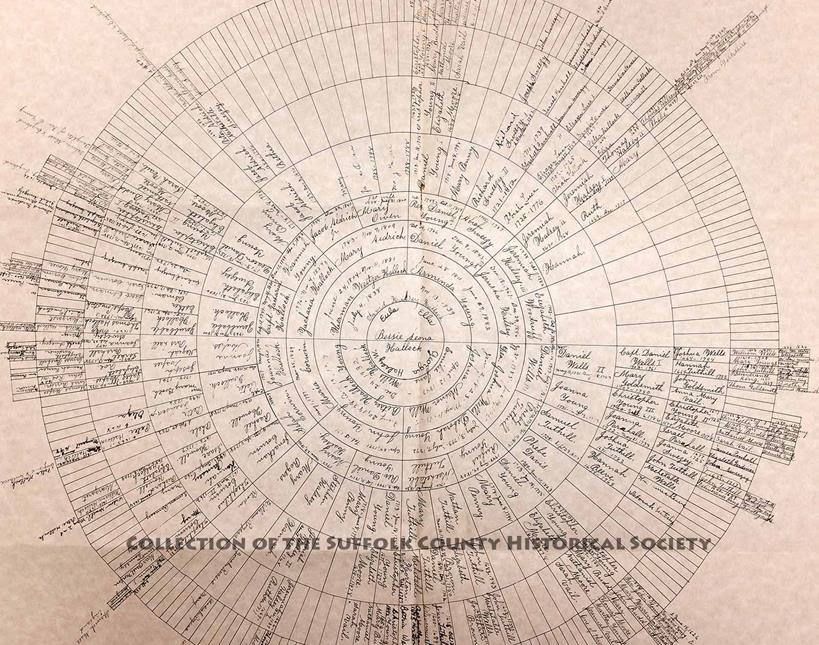
Hallock / Terry Genealogy Chart. (From the Collection of the Suffolk County Historical Society Library Archives.)
There are all sorts of ways to record a family tree–from the basic ancestor chart and family group chart to electronic programs to creative works of genealogy art. Most family history researchers begin with a simple chart or ancestor list to record information about themselves, their parents, grandparents, and great-grandparents. They search for birth, marriage, and death certificates and other documents, including religious records, old letters, photographs, and other memorabilia, recording their sources along the way. Once the first few branches of a family tree are recorded, the researcher continues moving backwards to methodically complete the tree, a time-consuming labor of love. The Hallock / Terry Genealogy Chart pictured here is designed in an intricate circular format, tracing lines of the family back many generations, from the 1900s back to the 1600s.
Speaking of the Hallocks, don’t miss the Suffolk County Historical Society Booth at the 38th Annual Hallockville Country Fair and Craft Show today and tomorrow (August 25 and 26, 10 am – 5 pm). Located on Sound Avenue in Riverhead, Hallockville’s annual event features local craft guilds and artisan vendors, tours of the historic buildings, children’s activities, and much more.
******************************************
Visit: www.suffolkcountyhistoricalsociety.org
To View 2014 Photo of the Week pages click here.
To View 2015 Photo of the Week pages click here.
To View 2016 Photo of the Week pages click here.
To View 2017 Photo of the Week pages click here.
******************************************
PHOTO OF THE WEEK: August 18, 2018— FROM THE SCHS LIBRARY ARCHIVES
“How shall we know it is us without our past?”
– John SteinbeckThe Hamlet of Peconic
by Wendy Polhemus-Annibell, Head Librarian
The Old Peconic Railroad Station, c. 1920s. (From the Collection of the Suffolk County Historical Society Library Archives. Image © Suffolk County Historical Society. All rights reserved.)
The hamlet of Peconic, originally known as Hermitage, had a railroad station as early as the 1840s along the Greenport LIRR line. The station built on the south side of the tracks also served as the post office, where Frank H. Overton and James B. Fanning served as postmasters. The station house is no longer standing, and the LIRR discontinued the Peconic stop in the 1970s.
Located on the North Fork between Cutchogue and Southold, early Peconic was home to the Old Grist Mill at Goldsmith Inlet and to a row of retired whaling captains on its Main Road, including the well-known Capt. Henry Green who in his retirement years became a Peconic farmer. The hamlet also has the distinction (sometimes shared with Cutchogue) of being the place in New York State with the greatest number of sunny days.
******************************************
Visit: www.suffolkcountyhistoricalsociety.org
To View 2014 Photo of the Week pages click here.
To View 2015 Photo of the Week pages click here.
To View 2016 Photo of the Week pages click here.
To View 2017 Photo of the Week pages click here.
******************************************
PHOTO OF THE WEEK: August 4, 2018— FROM THE SCHS LIBRARY ARCHIVES
“How shall we know it is us without our past?”
– John Steinbeck“Good Old Summer Time”
by Wendy Polhemus-Annibell, Head Librarian
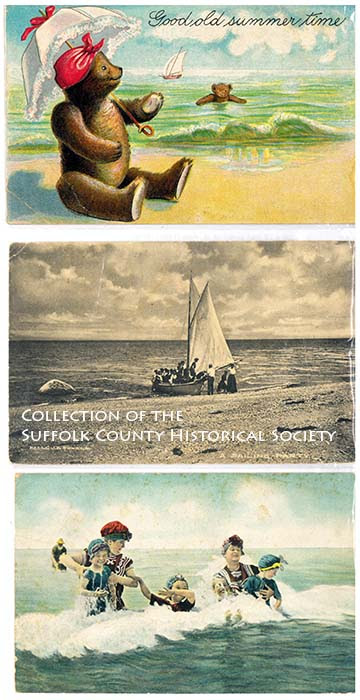
“Good Old Summer Time” Postcards, 1910. (From the Collection of the Suffolk County Historical Society Library Archives. Image collage © Suffolk County Historical Society. All rights reserved.)
We hope everyone is enjoying the summer months of fun, sun, and relaxation. These items from our extensive Postcard Collection are postmarked 1910 and are from the 1-cent postcard postage era. The top postcard, entitled “Good Old Summer Time,” was addressed to Allamay Hallock of Sound Avenue in Riverhead. The middle postcard, sent to Mr. P.L. Hall of Farmingdale and postmarked in Miller Place, includes the following message about a Long Island Sound beach:
“Dear Pency, You would enjoy this beach so much, I think. There are beautiful stones and shells, and how would you like to go out in this sailboat? One came up very close to the shore the other day while we were in for our swims.”
The bottom postcard was addressed to Miss Alta Hallock at Sound Avenue, Riverhead, and signed, “With lots of love from Dorothy.”
******************************************
Visit: www.suffolkcountyhistoricalsociety.org
To View 2014 Photo of the Week pages click here.
To View 2015 Photo of the Week pages click here.
To View 2016 Photo of the Week pages click here.
To View 2017 Photo of the Week pages click here.
******************************************
PHOTO OF THE WEEK: July 28, 2018— FROM THE SCHS LIBRARY ARCHIVES
“How shall we know it is us without our past?”
– John Steinbeck
Tesla Tower Wardenclyffe Lab, Shoreham
by Wendy Polhemus-Annibell, Head Librarian

Tesla Tower and Wardenclyffe Lab, Shoreham, c. 1902. (From the Collection of the Suffolk County Historical Society Library Archives. Images © Suffolk County Historical Society. All rights reserved.)
In 1901, the inventor Nikola Tesla purchased two hundred acres on Route 25A in Shoreham from James Warden for the purpose of establishing his Wardenclyffe lab and transmitter tower. The laboratory was designed by the renowned architect Stanford White, and the project was funded by J.P. Morgan. Known as the Wardenclyffe Tower or the Tesla Tower, the large structure stood 187 feet tall and was buried 120 feet below ground.
Tesla’s experimental wireless transmission station in the small hamlet of Shoreham was meant to be the world’s first communications center capable of transmitting messages across the globe. It was also meant to wirelessly transmit electrical power from a power plant in Niagara Falls to locations throughout the world! In 1903 Tesla tested the tower for the first and only time, creating loud noises and displays of bright lights across the Shoreham area. His project was short-lived, however, and was abandoned in 1906 due to funding issues with J.P. Morgan, who realized that Tesla’s invention would compete with power lines he owned. The tower was demolished in 1917, and the laboratory still stands on the property known today as the Tesla Science Center.
Jane Alcorn from the Tesla Science Center will present a Book & Bottle talk on Nikola Tesla and the Wardenclyffe site on Thursday, August 2nd at 6:00 pm at the Suffolk County Historical Society Museum. Be sure to reserve your seat by calling us at 631-727-2881 x100.

******************************************
Visit: www.suffolkcountyhistoricalsociety.org
To View 2014 Photo of the Week pages click here.
To View 2015 Photo of the Week pages click here.
To View 2016 Photo of the Week pages click here.
To View 2017 Photo of the Week pages click here.
******************************************
PHOTO OF THE WEEK: July 21, 2018— FROM THE SCHS LIBRARY ARCHIVES
“How shall we know it is us without our past?”
– John Steinbeck
SUFFOLK COUNTY ROADWAYS, 1930s / 1950s
by Wendy Polhemus-Annibell, Head Librarian
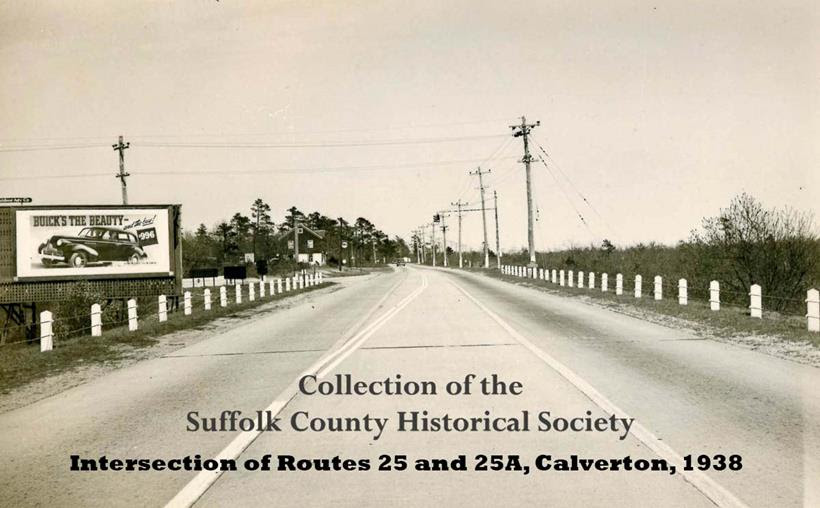


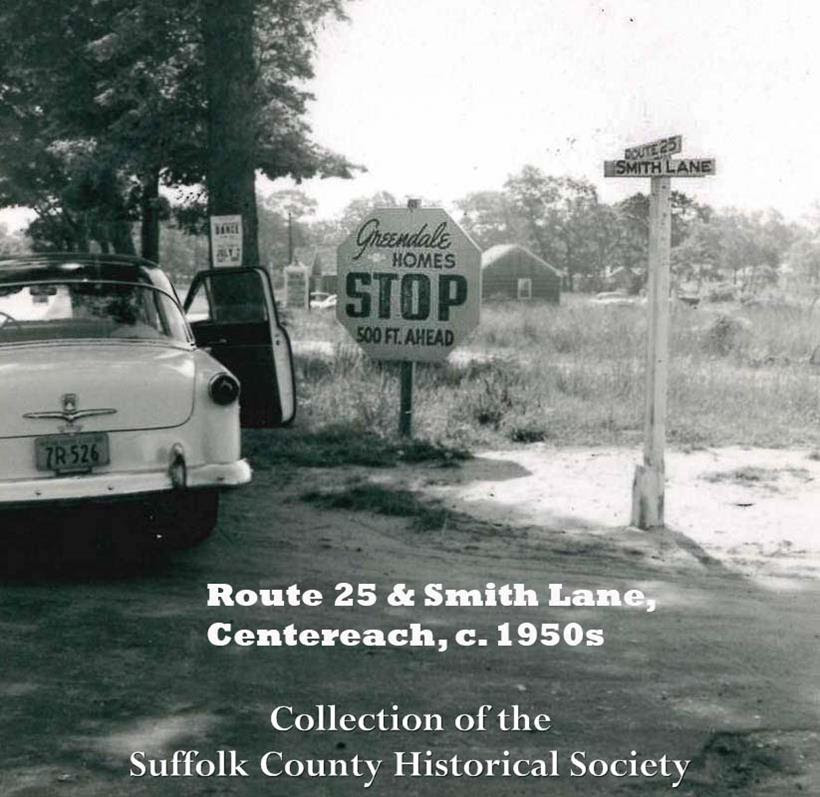
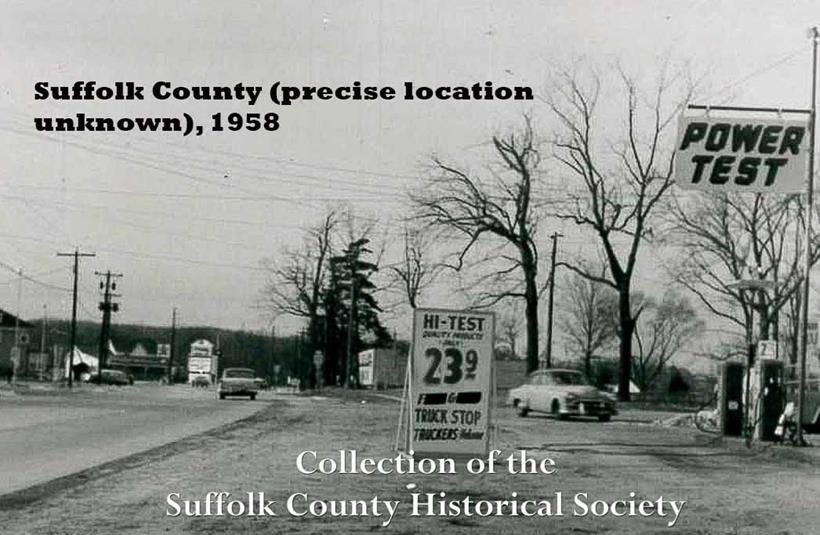
Early to Mid- 20th-Century Roadway Images from Our Ceylon Anderson Photography Collection. (From the Collection of the Suffolk County Historical Society Library Archives. Images © Suffolk County Historical Society. All rights reserved.)
Ceylon Anderson (1904-1988), a resident of Riverhead, worked as a traffic engineer for the New York State Department of Transportation for over forty years. During this time period he documented through photography the development of roadways on Long Island–from the early winding paths to the modern roads and highways we know today. Thousands of his street and hamlet images, shot at locations across Long Island, were donated to the Suffolk County Historical Society’s research library. The small selection of images shown here are of assorted roadways in Suffolk County in the 1930s to the 1950s.
The Ceylon Anderson Collection is viewable in our research library, which is open on Wednesday through Saturday, 12:30 pm – 4:30 pm.
**************************

Don’t miss our next BOOK & BOTTLE with Jane Alcorn on NIKOLA TESLA: WHO WAS HE? ~ Thursday, August 2, at 6:00 pm. Space is limited! Call today to reserve! 631-727-2881 x100.
************************************
Visit: www.suffolkcountyhistoricalsociety.org
To View 2014 Photo of the Week pages click here.
To View 2015 Photo of the Week pages click here.
To View 2016 Photo of the Week pages click here.
To View 2017 Photo of the Week pages click here.
*************************************
PHOTO OF THE WEEK: July 14, 2018— FROM THE SCHS LIBRARY ARCHIVES
“How shall we know it is us without our past?”
– John Steinbeck
Family Bible Records
by Wendy Polhemus-Annibell, Head Librarian
Pages from a Barnes Family Bible Record, 1744-1869. (From the Bible Records Collection of the Suffolk County Historical Society Library Archives. Image © Suffolk County Historical Society. All rights reserved.)
Many families have traditionally recorded births, marriages, and deaths in a family Bible or family record book, and then passed that Bible or book down from one generation of relatives to the next. These primary source family records are a valuable resource for professional and hobbyist genealogists alike. In addition to births, marriages, and deaths, a family Bible or record book may identify where a special event took place–as well as the joy or heartache the recorder felt when inscribing the event description. Within any given family Bible or record book one may also discover such items as news clippings, scribbles, poetry, schoolwork, and correspondences, all of which provide insights into a family’s private life that may otherwise be lost.
The SCHS Library Archives has a collection of Bible records from many of the old families of Suffolk County. Most of these records have been photocopied from the family Bibles’ pages or have been transcribed from a copy. We continue to collect these records for the old and new families of Suffolk County. Contact us if you’re interested in adding your Suffolk County family’s record book or Bible records to our Family Bible Records Collection!
—————————————
Don’t miss next week’s BOOK & BOTTLE with STEVE WICK on THE LAST FARMERS OF THE NORTH FORK ~ Thursday, July 19, at 6:00 pm. Call today to reserve your spot! 631-727-2881
******************************************
Visit: www.suffolkcountyhistoricalsociety.org
To View 2014 Photo of the Week pages click here.
To View 2015 Photo of the Week pages click here.
To View 2016 Photo of the Week pages click here.
To View 2017 Photo of the Week pages click here.
******************************************
PHOTO OF THE WEEK: June 30, 2018— FROM THE SCHS LIBRARY ARCHIVES
“How shall we know it is us without our past?”
– John Steinbeck
The Capital Theater, Riverhead, 1920s
by Wendy Polhemus-Annibell, Head Librarian
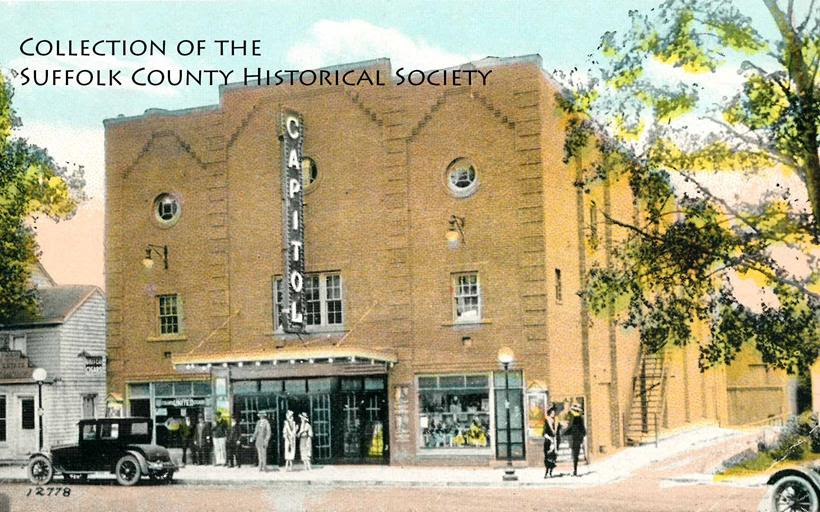
The Capitol Theater, Riverhead, 1920s. (Image from the Collection of the Suffolk County Historical Society Library Archives. Copyright © Suffolk County Historical Society. All rights reserved.
The Capitol Theatre opened on Main Street, Riverhead, on November 24, 1920. It was located a short walk west of the bank building at the corner of Main and Peconic, just about where the new Peconic Crossing apartments are currently being constructed.
The theater was erected by Robert E. Riley, a prominent Riverhead businessman who grew up in Calverton and had an interest in theater arts as a young boy. Riley also owned theaters in Sag Harbor, Greenport, and Babylon, among others. “I offer the Capitol for the appreciation of Riverhead citizens,” Riley noted in a newspaper announcement. “It is a big feature in the commerical development of the community and with your patronage we hope to prosper and to constantly increase the quality of our programs.”
The Capitol Theatre was reportedly one of the finest movie houses in Suffolk County for the time period. It wasn’t long after its opening, however, that the theater was sold, in 1925, and later renamed the Riverhead Theatre.
******************************************
Visit: www.suffolkcountyhistoricalsociety.org
To View 2014 Photo of the Week pages click here.
To View 2015 Photo of the Week pages click here.
To View 2016 Photo of the Week pages click here.
To View 2017 Photo of the Week pages click here.
******************************************
PHOTO OF THE WEEK: June 30, 2018— FROM THE SCHS LIBRARY ARCHIVES
“How shall we know it is us without our past?”
– John Steinbeck
JULY 4TH CELEBRATION
by Wendy Polhemus-Annibell, Head Librarian
July 4th Holiday Postcard. (From the Collection of the Suffolk County Historical Society Library Archives. Image Copyright © Suffolk County Historical Society. All rights reserved.)
On July 4, 1776, the thirteen colonies claimed their independence from England, an event that eventually led to the formation of the United States of America. Each year on the Fourth of July, also known as Independence Day, Americans celebrate this historic event. The Staff and Board of the Suffolk County Historical Society would like to wish all of our readers, members, and other supporters a happy and safe holiday celebration.
******************************************
Visit: www.suffolkcountyhistoricalsociety.org
To View 2014 Photo of the Week pages click here.
To View 2015 Photo of the Week pages click here.
To View 2016 Photo of the Week pages click here.
To View 2017 Photo of the Week pages click here.
******************************************
PHOTO OF THE WEEK: June 23, 2018— FROM THE SCHS LIBRARY ARCHIVES
“How shall we know it is us without our past?”
– John SteinbeckLong Island Duck Farmers Cooperative
by Wendy Polhemus-Annibell, Head Librarian
Long Island Duck Farmers Cooperative Marketing Materials, c. 1960. (Image from the Long Island Duck Farming Collection of the Suffolk County Historical Society Library Archives. Copyright © Suffolk County Historical Society. All rights reserved.)
In 1873 an enterprising American sea captain returned from a voyage to China with a souvenir of six white Pekin ducks. These downy immigrants waddled in the sandy soils of Long Island, found the climate hospitable, and began a new local industry. Capt. Charles T. Gordon was one of the first duck farmers on Long Island and pioneered a farm in Eastport that became one of the largest growers in the industry. Later, the combined output of Harry S. Baker of Eastport, Joseph Celic of Riverhead, and William J. Lukert of Moriches reached over one million ducks a year.
Long Island was an ideal growing area for ducks in America, providing a happy combination of proper weather conditions, soils, and water. At one time there were over 125 duck growers on Long Island. By 1958 there were 61 growers producing more ducks than ever, each averaging over 100,000 ducks a year. The Long Island Duck Farmers Cooperative, organized in circa 1960 with processing plants in Riverhead and Eastport, lasted about 25 years; the two plants had a combined processing capacity of 6,000 ducks an hour, according to News for Farmer Cooperatives.
Our Long Island Duck Farming Collection includes published works, postcards, photographs, and marketing materials such as those shown here. Whether you wanted to “Cook In” or “Cook Out” or serve your duck with sauce, the Long Island duckling once accounted for one-half of all the ducks produced annually in the United States. Today, Crescent Duck Farm in Aquebogue is the last duck farm still in business on Long Island.
~~~~~~~~~~~~~~~~~~~~~~~~~~~~~~~~~~~~~~~~
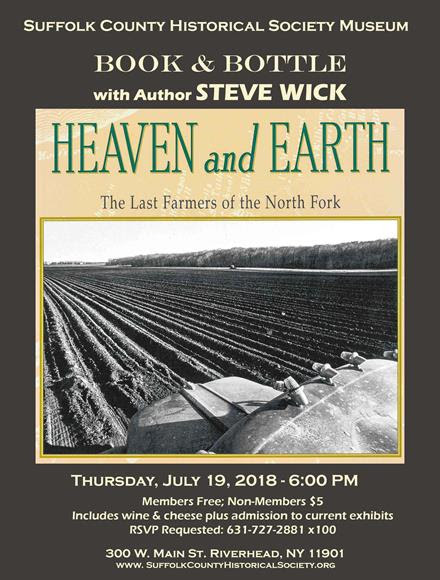 BOOK & BOTTLE
BOOK & BOTTLE
Join us on Thursday, July 19, 2018, 6:00 pm
THE LAST FARMERS OF THE NORTH FORK
A book talk with author
STEVE WICK
Members Free; Non-Members $5
RSVP Requested
631-727-2881 x100
******************************************
Visit: www.suffolkcountyhistoricalsociety.org
To View 2014 Photo of the Week pages click here.
To View 2015 Photo of the Week pages click here.
To View 2016 Photo of the Week pages click here.
To View 2017 Photo of the Week pages click here.
******************************************
PHOTO OF THE WEEK: June 16, 2018— FROM THE SCHS LIBRARY ARCHIVES
“How shall we know it is us without our past?”
– John SteinbeckBurrwood Estate, Cold Spring Harbor
by Wendy Polhemus-Annibell, Head Librarian
Burrwood Estate, Cold Spring Harbor. (Image from the Huntington Pictorial Collection of the Suffolk County Historical Society Library Archives. Copyright © Suffolk County Historical Society. All rights reserved.)
The Burrwood estate was set on 250 acres overlooking Cold Spring Harbor, and was later expanded to over a thousand acres. It was built in about 1899 for Walter Jennings by Carrère & Hastings of NYC. Jennings was a director of the Standard Oil Company and president of the National Fuel Gas Company. The property also featured a number of outbuildings, including an extensive brick farm complex designed by J. Clinton Mackensie. The landscaped grounds and formal gardens were updated around 1916 by the Olmstead Brothers, who also designed Planting Fields in Oyster Bay. Among other improvements, a new rose garden was perched on a bluff slightly higher than the house and separated from the house by a deep gorge, which featured a ravine garden and a circular pool.
After Jennings and his wife passed on, their son, Oliver Burr Jennings, inherited the Burrwood estate and eventually sold it to the Industrial Home for the Blind, which occupied the property from 1952 until 1985. Later the estate was sold for development and demolished in 1993. It’s said that pieces of the gardens remain, as do a few brick walls and the entrance gates.
******************************************
Visit: www.suffolkcountyhistoricalsociety.org
To View 2014 Photo of the Week pages click here.
To View 2015 Photo of the Week pages click here.
To View 2016 Photo of the Week pages click here.
To View 2017 Photo of the Week pages click here.
******************************************
PHOTO OF THE WEEK: June 9, 2018— FROM THE SCHS LIBRARY ARCHIVES
“How shall we know it is us without our past?”
– John SteinbeckCranberry Marsh, Manorville
by Wendy Polhemus-Annibell, Head Librarian
Mr. George Davis at the Site of His Cranberry Marsh, Manorville, c. 1890. (Image from the Brookhaven Pictorial Collection of the Suffolk County Historical Society Library Archives. Copyright © Suffolk County Historical Society. All rights reserved.)
George Davis first planted his Manorville cranberry bog in 1890. It occupied 52 acres and produced 10,000 bushels of cranberries a year that sold under the brand name “Blue Diamond” to the Atlantic and Pacific Tea Company.
At the turn of the twentieth century, most of Suffolk County’s cranberry bogs were situated in the Riverhead-Calverton-Manorville area along the wetlands of the Peconic River. During the peak years of production, some 25,000 bushels of cranberries were harvested annually from the marshes along the river. The largest cranberry operation was run by Sylvester Woodhull of Riverhead. Other growers, in addition to the Davis and Woodhull marshes, included the Perkins Co. of Riverhead and E. L. Brown of Calverton. Suffolk County at the time was the third largest producer of cranberries in the country, behind only Wisconsin and Massachusetts.
By World War II, however, only a few cranberry bogs remained on Long Island. The Davis bog held out to collect its last harvest in 1975. Several factors contributed to the eventual decline of the cranberry industry in the area, but the most devastating was the 1959 ban on amino triazole, a weed killer used extensively by cranberry farmers.
——————————————-
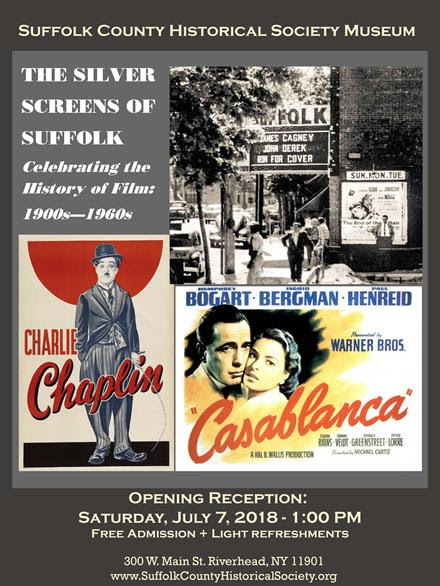
EXHIBITJoin us on Sat., July 7, 2018 – 1:00 pm – for an OPENING RECEPTION: The Silver Screens of Suffolk County. Celebrating the History of Film: 1900s to 1960s. Free Opening Day Admission. Light refreshments will be served.
The magic of cinema has been captivating America for over 100 years. Though the origins of early cinema are complex, Suffolk County played a surprising role in the early stages of the silent film industry! This exhibit will celebrate the history of film, illustrating its early connections to Suffolk County and our area’s charming local theaters, while also outlining cinema history through a showcase of one of the finest private collections of movie posters, programs, heralds, and theater window cards. From silent films to Hollywood legends, sci-fi to Disney animations, Silver Screens of Suffolk promises a fun-filled adventure for all ages! On exhibit in our Grand Staas Gallery, July 7, 2018 to February 28, 2019.
******************************************
Visit: www.suffolkcountyhistoricalsociety.org
To View 2014 Photo of the Week pages click here.
To View 2015 Photo of the Week pages click here.
To View 2016 Photo of the Week pages click here.
To View 2017 Photo of the Week pages click here.
******************************************
PHOTO OF THE WEEK: June 2, 2018— FROM THE SCHS LIBRARY ARCHIVES
“How shall we know it is us without our past?”
– John SteinbeckThe Suffolk Theater, Riverhead
by Wendy Polhemus-Annibell, Head Librarian
The Suffolk Theater, Riverhead, 1955. (Image from the Sigal Collection of the Suffolk County Historical Society Library Archives. Copyright © Suffolk County Historical Society. All rights reserved.)
Long Island movie theater tycoon A. H. Schwartz completed the art-deco style Suffolk Theater on Main Street in historic downtown Riverhead in 1933. Designed by New York architect R. Thomas Short, the art deco details included floral and sunburst designs, zigzags, glazed brick and terra-cotta, and geometric surface ornament. The Suffolk Theater is the last remaining movie house built by Short and is the last remaining large art deco theater on Long Island.
The theater was built as a National Recovery Act project for the Century Theater circuit chain. Construction of the 800-seat theater took only two and a half months, and the theater opened in January 1934. The Riverhead News reported at that time that the Suffolk Theater provided “the best in picture and sound entertainment” and “modern construction in every detail.” A large refrigeration and air-conditioning system was installed for the comfort of moviegoers, along with a high-fidelity sound system and “fine projection materials.” Motion picture fans in Riverhead in the 1930s could now enjoy the same high standards as those in the “two finest theaters in the country, the Roxy and the International Music Hall of Radio City.”
In the above 1955 Main Street scene, the Suffolk Theater was showing Run for Cover, a technicolor western film directed by Nicholas Ray and starring James Cagney, Viveca Lindfors, and John Derek.
Join us on Sat., July 7, 2018 – 1:00 pm – for an OPENING RECEPTION: The Silver Screens of Suffolk County. Celebrating the History of Film: 1900s to 1960s. Free Opening Day Admission. Light refreshments will be served.
The magic of cinema has been captivating America for over 100 years. Though the origins of early cinema are complex, Suffolk County played a surprising role in the early stages of the silent film industry! This exhibit will celebrate the history of film, illustrating its early connections to Suffolk County and our area’s charming local theaters, while also outlining cinema history through a showcase of one of the finest private collections of movie posters, programs, heralds, and theater window cards. From silent films to Hollywood legends, sci-fi to Disney animations, Silver Screens of Suffolk promises a fun-filled adventure for all ages! On exhibit in our Grand Staas Gallery, July 7, 2018 to February 28, 2019.
******************************************
Visit: www.suffolkcountyhistoricalsociety.org
To View 2014 Photo of the Week pages click here.
To View 2015 Photo of the Week pages click here.
To View 2016 Photo of the Week pages click here.
To View 2017 Photo of the Week pages click here.
******************************************
PHOTO OF THE WEEK: May 26, 2018— FROM THE SCHS LIBRARY ARCHIVES
“How shall we know it is us without our past?”
– John SteinbeckThe Hulbert Flag
by Wendy Polhemus-Annibell, Head Librarian
The Hulbert Flag. (Image from the Collection of the Suffolk County Historical Society. Copyright © Suffolk County Historical Society. All rights reserved.)
A controversial artifact from the Suffolk County Historical Society Museum’s permanent collection, the Hulbert flag is believed by some to have been made by Captain John Hulbert of Bridgehampton and carried by him and his militiamen from Fort Ticonderoga to Philadelphia in 1775–where, after having been seen by representatives at the Continental Congress, it might have influenced the design of the first American flag. Found in the 1920s with some revolutionary war documents in a Bridgehampton attic and donated to the museum, the thirteen-star flag has been examined by a number of experts who remain divided over the oral tradition of the flag’s origins. The Hulbert flag nonetheless remains an interesting part of Suffolk County’s history as well as one of the best-known and most discussed artifacts in our museum’s collection.
HOLIDAY CLOSURE
Please note we will be closed on Saturday, May 26 in observance of the Memorial Day holiday.
Happy Memorial Day to all of our friends, readers, and supporters of local history!
******************************************
Visit: www.suffolkcountyhistoricalsociety.org
To View 2014 Photo of the Week pages click here.
To View 2015 Photo of the Week pages click here.
To View 2016 Photo of the Week pages click here.
To View 2017 Photo of the Week pages click here.
******************************************
PHOTO OF THE WEEK: May 19, 2018— FROM THE SCHS LIBRARY ARCHIVES
“How shall we know it is us without our past?”
– John SteinbeckSUFFOLK COUNTY HISTORICAL SOCIETY RESEARCH LIBRARY
by Wendy Polhemus-Annibell, Head Librarian
The SCHS Library & Archives. (Image from the Suffolk County Historical Society Library Archives.)
The Suffolk County Historical Society, founded in 1886, has had a research library and archives since the early years of its organization. A great many years have gone into establishing the collection. The current Helen Raynor Hannah Memorial Library located in the west wing of the museum was opened to the public in April 1982.
The library is a special library, which means its holdings are primarily related to the cultural, social, and family histories of Suffolk County, though we also have some holdings about all of Long Island and New York state. Materials are not circulated but are used within the physical confines of the library.
In addition to a large collection of published books and pamphlets, the library collection features wills, deeds, bills of sale, letters, account books and ledgers, journals and diaries, genealogical manuscripts and collections of family papers, maps and atlases, photographs, and scrapbooks. Vertical files arranged both topically and by the ten towns of Suffolk County may contain such items as newspaper clippings, commemorative programs, brochures, and other informational materials. We also have file drawers containing records on the schools, churches, military, railroads, and cemeteries of Suffolk County. A few of our specialized collections include our Fullerton photograph collection of early 20th-century Long Island, the ornithological records of Leroy S. Wilcox, and the application papers and other records of the Daughters of the Revolution of 1776, among many others.
Periodical holdings include extensive collections of the Long Island Forum and the New York Genealogical & Biographical Record. Our newspaper collection, highly prized by researchers of local and family history, includes a varied collection of titles, though our most extensive newspaper holdings are of the Riverhead News and News-Review, the Sunday Review, and the County Review.
We wish to extend special thanks to the dedicated volunteers at the German Genealogy Group for creating a new searchable database of our biographical materials. The database is available here: http://www.germangenealogygroup.com/records-search/Suffolk-Biographical-Index.php
The Suffolk County Historical Society Research Library is open from Wednesday to Saturday, 12:30 pm to 4:30 pm, with a $2 per day library use donation for non-members.
******************************************
Visit: www.suffolkcountyhistoricalsociety.org
To View 2014 Photo of the Week pages click here.
To View 2015 Photo of the Week pages click here.
To View 2016 Photo of the Week pages click here.
To View 2017 Photo of the Week pages click here.
******************************************
PHOTO OF THE WEEK: May 12, 2018— FROM THE SCHS LIBRARY ARCHIVES
“How shall we know it is us without our past?”
– John SteinbeckMOTHER’S DAY
by Wendy Polhemus-Annibell, Head Librarian
“Narrow Blue Flag Iris” Postcard, 1957. (Image from the Collection of the Suffolk County Historical Society Library Archives.)
Suffolk County Historical Society
wishes all of our members, friends, and supporters
a very Happy Mother’s Day!
Mother’s Day, a holiday honoring motherhood, is celebrated by presenting mothers and other women with gifts and flowers. The holiday has become one of the biggest holidays for consumer spending. Founded by Anna Jarvis in 1908, the American Mother’s Day became an official holiday in 1914. However, the origins of Mother’s Day in America date back to the nineteenth century, when in the years preceding the Civil War, Anna’s mother, Ann Reeves Jarvis of West Virginia, helped start “Mothers’ Day Work Clubs” to teach local women how to properly care for their children. These clubs later became a unifying force in a region of the country still divided over the Civil War. In 1868, Jarvis organized “Mothers Friendship Day,” when mothers gathered with former Union and Confederate soldiers to promote reconciliation.
Another precursor to Mother’s Day came from the abolitionist and suffragist Julia Ward Howe. In 1870 Howe wrote the “Mother’s Day Proclamation,” a call to action that asked mothers to unite in promoting world peace. At times in the 20th century, Mother’s Day has also been a date for launching social causes. In 1968, for example, Coretta Scott King, wife of Martin Luther King Jr., used Mother’s Day to host a march in support of underprivileged women and children. In the 1970s, women’s groups used the holiday as a time to highlight the need for equal rights and access to childcare.
******************************************
Visit: www.suffolkcountyhistoricalsociety.org
To View 2014 Photo of the Week pages click here.
To View 2015 Photo of the Week pages click here.
To View 2016 Photo of the Week pages click here.
To View 2017 Photo of the Week pages click here.
******************************************
PHOTO OF THE WEEK: May 5, 2018— FROM THE SCHS LIBRARY ARCHIVES
“How shall we know it is us without our past?”
– John Steinbeck
FULLERTON’S WADING RIVER EXPERIMENTAL FARM
by Wendy Polhemus-Annibell, Head Librarian
[ To view the Fullerton photo, please visit the Suffolk County Historical Society’s website / newsletter.] Edith Fullerton Among the Tomato Harvest, Wading River, c. 1900, by Hal B. Fullerton. Hand-colored. (From the Harry T. Tuthill Fullerton Collection of the Suffolk County Historical Society Library Archives. Copyright © Suffolk County Historical Society. All rights reserved.)
Edith Loring Fullerton, photographer Hal B. Fullerton’s spouse, is shown here at the Wading River Experimental Farm cleaning tomatoes by the railroad tracks that extended to the area in the early twentieth century. In the large-sized print one can see that the tomatoes themselves share the size and shape of the heirloom tomato known today as ‘Brandywine.’
On those 10 acres of land at Wading River, Edith and her husband set up LIRR Experimental Farm #1, nicknamed “Peace and Plenty.” Their success at Wading River led to LIRR Experimental Farm #2, “Prosperity Farm,” in Medford, where 80 acres were cleared and planted. Over a period of many years during the early twentieth century, both farms were an enormous success, as the Fullertons grew nearly a thousand varieties of produce, many of them prize-winners at county and state fairs.
In 1905, Edith wrote about tomatoes and other gardening topics in her book How to Make a Vegetable Garden: “The tomato…is a native of a warm climate, that of South America, and in the old days it was considered a curious rarity in North America. Its name was then the ‘Love Apple,’ for it was so often used in courtship as to be highly prized by the damsel who received it from her preferred lover; and it was also much in demand as a mantel ornament. Great was the dismay among our grandmothers when the younger generation began eating the fruit, for it was considered distinctly poisonous. The original tomato was very small, not much larger than a cherry, and it has been used in our country as an edible only during the last 50 years…. We always have two kinds [of tomatoes] in our garden, large red and yellow egg.”
******************************************
Visit: www.suffolkcountyhistoricalsociety.org
To View 2014 Photo of the Week pages click here.
To View 2015 Photo of the Week pages click here.
To View 2016 Photo of the Week pages click here.
To View 2017 Photo of the Week pages click here.
******************************************
PHOTO OF THE WEEK: April 28, 2018— FROM THE SCHS LIBRARY ARCHIVES
“How shall we know it is us without our past?”
– John Steinbeck
PECONIC RIVER
by Wendy Polhemus-Annibell, Head Librarian
[ To view the Fullerton photo, please visit the Suffolk County Historical Society’s website / newsletter.] Head of the Peconic River at Riverhead, with Fish Net on Reel in Foreground, 1901. (From the Harry T. Tuthill Fullerton Collection of the Suffolk County Historical Society Library Archives. Copyright © Suffolk County Historical Society. All rights reserved.)
Few rivers in New York state rival Long Island’s Peconic in natural beauty, ecological diversity, and historical richness. The 15-mile-long river flows through lands located in the towns of Brookhaven, Riverhead, and Southampton, through swamps, bogs, and the woodlands of the Pine Barrens, alongside farmlands, and beneath roadways, until it empties into the Peconic Bay, the so-called “head” of the river that gave Riverhead its name.
For most of its length, the Peconic is a freshwater river, but at the hamlet of Riverhead it becomes a saltwater estuary subject to tidal action. Although the Peconic is quite wide in some places, it is very shallow. Its water is also naturally low in nutrients, acidic, and relatively warm, coming from the groundwater aquifer by seepage. Since the soils of the Peconic watershed are very porous, there is little runoff from the river. Ecologically, the Peconic is among the most diverse rivers in the state, home to many plants and animals that are rare or absent elsewhere.
The Indian name Peconic, originally spelled Peaconnock, means “small plantation,” apparently in reference to an early Indian settlement on the shore near Aquebogue. The upper river was also called Red Creek by early settlers due to the wine or tea color of the water caused by its tannin and iron content.
Suggested Reading: “The Peconic River,” by David Newton (1983).
******************************************
Visit: www.suffolkcountyhistoricalsociety.org
To View 2014 Photo of the Week pages click here.
To View 2015 Photo of the Week pages click here.
To View 2016 Photo of the Week pages click here.
To View 2017 Photo of the Week pages click here.
******************************************
PHOTO OF THE WEEK: April 21, 2018— FROM THE SCHS LIBRARY ARCHIVES
“How shall we know it is us without our past?”
– John Steinbeck
GRACE FLOYD DELAFIELD ROBINSON
by Wendy Polhemus-Annibell, Head Librarian
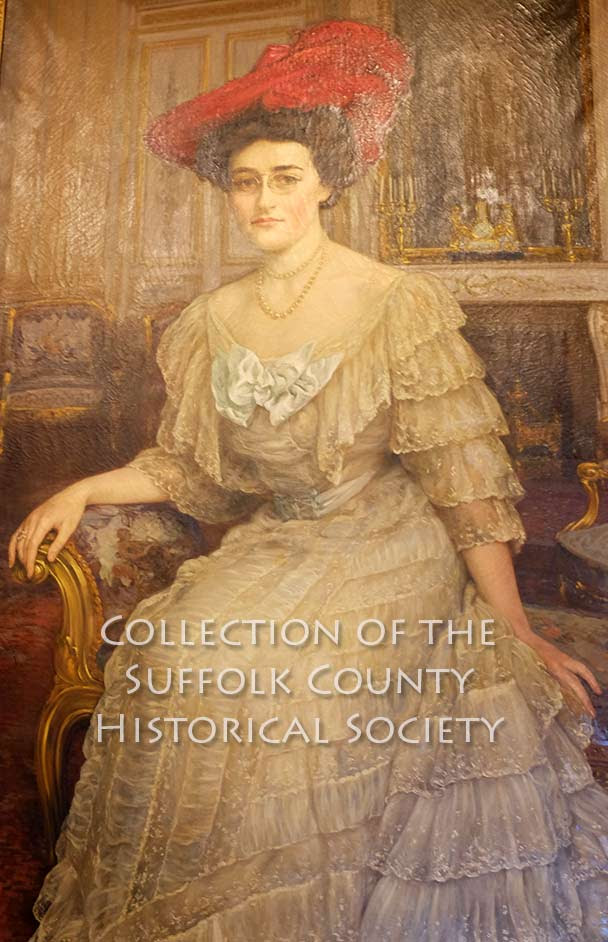
Portrait of Grace Floyd Delafield Robinson. (From the Collection of the Suffolk County Historical Society. Copyright Suffolk County Historical Society. All rights reserved.)
Floyd Delafield Robinson (1883-1954) was a direct descendant of William Floyd, a signer of the Declaration of Independence. This painting by artist E. D. Jewett, featured in our History in the Hall Gallery, depicts Mrs. Robinson in her family home in New York City. She and her family also owned a summer home in Greenport, Brecknock Hall, a stone mansion originally constructed in circa 1857 by David Gelston Floyd (1802-1898), a grandson of William Floyd.
Grace moved to Greenport full time after her husband’s death in 1938. In 1944, Grace donated a chapel and altar to Holy Trinity Church–both of which were built of the walnut trees at Brecknock Hall that had fallen in the hurricane of 1938. Together with her husband and parents, Grace is buried in the family plot at Sterling Cemetery in Greenport.
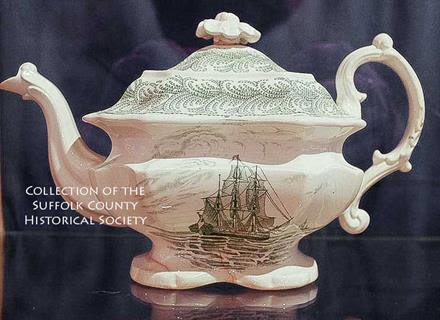
This teapot, owned by Grace’s mother, Julia Floyd Delafield (1846-1929), is one of many nineteenth-century teapots on display in our newest Spotlight Series exhibit: A Moment of Tranquili–Tea. The Suffolk County Historical Society has over a hundred teapots in our collection, and is pleased to present the finest examples of nineteenth-century teapots in this exhibit. On display in our History in the Hall Gallery, April 21 – July 28, 2018.
Suggested Reading: Brecknock Hall – The Floyd Family and Their Estate in Greenport, by Geoffrey K. Fleming.
******************************************
Visit: www.suffolkcountyhistoricalsociety.org
To View 2014 Photo of the Week pages click here.
To View 2015 Photo of the Week pages click here.
To View 2016 Photo of the Week pages click here.
To View 2017 Photo of the Week pages click here.
******************************************
PHOTO OF THE WEEK: April 14, 2018— FROM THE SCHS LIBRARY ARCHIVES
“How shall we know it is us without our past?”
– John SteinbeckLloyd Harbor
by Wendy Polhemus-Annibell, Head Librarian
[ To view the Fullerton photo, please visit the Suffolk County Historical Society’s website / newsletter.] Lloyd Harbor with Two-Masted Schooner, 1900. (From the Harry T. Tuthill Fullerton Collection of the Suffolk County Historical Society Library Archives. Image © copyright Suffolk County Historical Society. All rights reserved.)
The village of Lloyd Harbor, incorporated in 1926, occupies about nine square miles in the Town of Huntington. Its two sections–the Lloyd Neck peninsula that juts out into the Sound and the mainland West Neck area–are held together by a causeway. The first known inhabitants of the area, however, were the Matinecock Indians, who called Lloyd Neck “Caumsett” for “a place of sharp rocks.” English settlers arrived in 1654, and in 1676, a Boston merchant named James Lloyd took title to thousands of acres of land in the area under a colonial patent. His son Henry Lloyd moved to Lloyd Neck and built a manor house, which still stands today, on the grounds of Caumsett Historic State Park.
In addition to giving the village its name, the Lloyds are associated with Jupiter Hammon, the first published African American poet in America. Born into slavery at Henry Lloyd’s estate, Hammon was reportedly allowed access to the manor’s library and was educated with the estate owner’s children, even working with Henry Lloyd in his business ventures. Hammon’s first published work, “An Evening Thought” (also referred to as “An Evening Prayer” and “An Evening’s Thought: Salvation by Christ, with Penitential Cries”), was published in 1760. Considered a religious poet, Hammon also served as a preacher to other enslaved members of the Lloyd estate, and in 1787 made a speech to the African Society of NYC entitled “An Address to the Negroes in the State of New York.” Jupiter Hammon was buried in an unmarked grave on the Lloyd estate.
Suggested Reading: A History of the Incorporated Village of Lloyd Harbor (1976).
******************************************
Visit: www.suffolkcountyhistoricalsociety.org
To View 2014 Photo of the Week pages click here.
To View 2015 Photo of the Week pages click here.
To View 2016 Photo of the Week pages click here.
To View 2017 Photo of the Week pages click here.
******************************************
PHOTO OF THE WEEK: April 7, 2018— FROM THE SCHS LIBRARY ARCHIVES
“How shall we know it is us without our past?”
– John Steinbeck
BOY SCOUT WAR GARDEN
by Wendy Polhemus-Annibell, Head Librarian
[ To view the Fullerton photo, please visit the Suffolk County Historical Society’s website / newsletter.]
Boy Scouts War Garden, Medford, 1918, by Hal B. Fullerton. (From the Harry T. Tuthill Fullerton Collection of the Suffolk County Historical Society Library Archives. Image © copyright Suffolk County Historical Society. All rights reserved.)
During World War I, the Long Island Rail Road and local farmers organized the Long Island Food Reserve Battalion. Sale of food to the Allies became a significant source of income to farmers, and the American entry into the war in 1917 only increased that demand. The New York State School of Agriculture on Long Island (today, Farmingdale State College), chartered in 1912, also played a role in securing materials and labor for area farmers. With many farm laborers drafted to serve in the war, however, high school students and Boy Scouts were recruited to work the farms of Long Island. Local schools cooperated with the effort by lengthening summer break from late May to November in order to maximize the availability of student farm workers.
Hal and Edith Fullerton of the LIRR’s Medford Experimental Farm participated in the Food Preserve Battalion by serving on the committee, providing lectures and canning demonstrations, and assisting with the distribution of seeds, fertilizer, and nursery stock. Edith also operated a canning kitchen for the railroad men who ran the trains to and from Camp Upton. She washed surgical dressings, visited patients, prepared them special baskets of fruit and biscuits, and even devised embroidery projects for the ailing soldiers as a form of physical therapy. Hal became involved in the Boy Scouts, organizing a troop for his son and other Medford boys and serving as scoutmaster and commissioner. He inaugurated a national victory garden program and assumed the proud title of Chief Grub Scout.
Suggested Reading: The Blessed Isle, by Charles L. Sachs (1991).
******************************************
Visit: www.suffolkcountyhistoricalsociety.org
To View 2014 Photo of the Week pages click here.
To View 2015 Photo of the Week pages click here.
To View 2016 Photo of the Week pages click here.
To View 2017 Photo of the Week pages click here.
******************************************
PHOTO OF THE WEEK: March 24, 2018— FROM THE SCHS LIBRARY ARCHIVES
“How shall we know it is us without our past?”
– John Steinbeck
Blue Point
by Wendy Polhemus-Annibell, Head Librarian
[ To view the Fullerton photo, please visit the Suffolk County Historical Society’s website / newsletter.] Blue Point Path, 1899, by Hal B. Fullerton. (From the Harry T. Tuthill Fullerton Collection of the Suffolk County Historical Society Library Archives. Image © copyright Suffolk County Historical Society. All rights reserved.)
How did Blue Point get its name? No one knows for sure. Some speculate that 17th-century baymen named the area after the blue haze they often viewed over this point of land that juts out into the Great South Bay. Native Americans knew the areas as Manowtassquot, “land of the basket rush,” after years of harvesting the area’s marshes to make baskets and mats. Deeded to English colonists in 1664, Blue Point was controlled by the Winthrop family until the mid-1700s, when it was sold to Humphrey Avery. The hamlet was also a strategic seaport held by the British during the Revolutionary War, a fact known to the rebels who frequently raided British ships docked in the harbor.
In the 1880s, Blue Point became a summer resort destination after the Stillman family, members of the Baptist Church, began performing baptisms at their bayside home. So many people began showing up to be baptized that the Stillmans built additional changing rooms outside their home. These evolved into bathhouses where visitors could rent bathing suits for 25 cents each. Stillman’s bathing beach eventually grew to include hundreds of bathhouses, and other resort hotels followed. Of course, the Blue Point Oyster, pulled by baymen from the hamlet’s rich oyster beds, became synonymous with the best oysters money could buy.
Suggested Reading: Gene Horton, Blue Point Remembered (1982).
Holiday Closure: The Suffolk County Historical Society will be closed for the holiday on Sat., March 31, and will reopen on Weds., April 4, at 10:00 a.m.
******************************************
Visit: www.suffolkcountyhistoricalsociety.org
To View 2014 Photo of the Week pages click here.
To View 2015 Photo of the Week pages click here.
To View 2016 Photo of the Week pages click here.
To View 2017 Photo of the Week pages click here.
******************************************
PHOTO OF THE WEEK: March 24, 2018— FROM THE SCHS LIBRARY ARCHIVES
“How shall we know it is us without our past?”
– John SteinbeckWading River Congregational Church
by Wendy Polhemus-Annibell, Head Librarian
Wading River Congregational Church. Undated photograph. (From the Riverhead Pictorial Collection of the Suffolk County Historical Society Library Archives. Image © copyright Suffolk County Historical Society. All rights reserved.)
The Congregational Church of Wading River was organized by the Rev. Daniel Young of Southold town (now Riverhead) in 1785. The first pastor of the church was the Rev. Jacob Corwin, whose services commenced in 1787 and continued until 1800. Other early pastors of the church included the Rev. David Wells, who continued to serve the church until his death in 1821, the Rev. Parshall Terry (until 1832), and the Rev. E. W. Griswold (until 1834).
A previous church building stood until 1837, when the present structure was erected. The bell for the new church was brought from New York City that year by Captain Vincent Davis on the sloop Venice. On January 1, 1838, the new church was dedicated, with a sermon by the Rev. Ezra King.
Suggested Reading: In our collection, the original 1837 Manual of the church.
******************************************
Visit: www.suffolkcountyhistoricalsociety.org
To View 2014 Photo of the Week pages click here.
To View 2015 Photo of the Week pages click here.
To View 2016 Photo of the Week pages click here.
To View 2017 Photo of the Week pages click here.
******************************************


~~~~~~~~~~~~~~~~~~~~~~~~~~~~~~~~~~~~~~~~~~
PHOTO OF THE WEEK: March 17, 2018— FROM THE SCHS LIBRARY ARCHIVES
“How shall we know it is us without our past?”
– John SteinbeckBlizzard of 1888
by Wendy Polhemus-Annibell, Head Librarian
Blizzard of 1888, Suffolk Tavern, Patchogue. (From the Vagts Pictorial Collection of the Suffolk County Historical Society Library Archives. Image © copyright Suffolk County Historical Society. All rights reserved.)
Last week marked the 130th anniversary of the Blizzard of 1888. Just as spring seemed to be around the corner on March 12-14 of that year, the storm raged for 72 hours, from Sunday night through Tuesday. Sometimes called the “Great White Hurricane,” the deadly blizzard overwhelmed the Northeast with single-digit temperatures, up to 90 mph winds, and 4-5 feet of snow, ultimately taking the lives of over 400 people.
Long Island was hit hard, with many areas recording nearly 40 inches of snow and two-story-high drifts. The blizzard knocked out telephone and telegraph lines, paralyzed the LIRR, and left people stranded in their homes without access to food. Residents on the eastern end of Long Island were isolated from the outside world, where the snow reportedly extended to the second floor of the Sag Harbor Express building. On Huntington’s Main Street the drifts were 10-15 feet high. A local police order required saloons, such as the Suffolk Tavern in Patchogue pictured here, to stay open all night to shelter stranded men, women, and children who had been caught off-guard by the storm and unable to reach their homes safely.
With the LIRR tracks blocked by snow, some mail for Long Island was routed to New London, Connecticut, and ferried across Long Island Sound, with small amounts arriving in Greenport about a week after the storm. In his diary, Richard Bayles of Middle Island accounted the fate of a group of travelers on a Monday morning train: “The train that got started from Greenport to the city got as far as Holbrook, where it was stuck in the snow banks and remained for two days. The passengers found a case of eggs in the baggage car, which they boiled in water from the locomotive, and a box of crackers found on the train helped out their menu.” Another train that had left Port Jefferson on Monday morning, March 12, was stalled in the snow for an entire week before reaching its Long Island City destination.
******************************************
Visit: www.suffolkcountyhistoricalsociety.org
To View 2014 Photo of the Week pages click here.
To View 2015 Photo of the Week pages click here.
To View 2016 Photo of the Week pages click here.
To View 2017 Photo of the Week pages click here.
******************************************


~~~~~~~~~~~~~~~~~~~~~~~~~~~~~~~~~~~~~~~~~~
PHOTO OF THE WEEK: March 10, 2018— FROM THE SCHS LIBRARY ARCHIVES
“How shall we know it is us without our past?”
– John Steinbeck
Camp Upton
by Wendy Polhemus-Annibell, Head Librarian
Tower on Headquarters Hill, Camp Upton. (From the Postcard Collection of the Suffolk County Historical Society Library Archives. Image © copyright Suffolk County Historical Society. All rights reserved.)
Camp Upton, built in 1917 as a training camp for the 77th Division, was named after Emory Upton, a Union general in the Civil War. Located near Yaphank in the heart of the Pine Barrens, the camp served as an induction and training facility for tens of thousands of soldiers who went on to fight in World War I. Shown in this postcard are the camp headquarters of Major General J. Franklin Bell, who was in command of Camp Upton from 1917 to 1918. The tower on the hill provided a 360-degree view of the entire camp. Soldiers were stationed on the tower to keep a constant eye on the camp. General Bell also used the tower to oversee the training of his troops.
Between the world wars, Camp Upton was used by members of the Civilian Conservation Corps, who planted many of the trees on the site. Then, in 1940, on the eve of World War II, Camp Upton was reopened to serve its original purpose as a military training ground. In 1944, the site was used as a hospital to treat wounded veterans of the war. It also served as a prisoner of war camp, when in 1945, five hundred German prisoners were sent to Camp Upton. In 1947, the camp was replaced by Brookhaven National Laboratory. (Further Reading: The History of Camp Upton, by Donald Bayles and Paul Infranco; Camp Upton, by Suzanne Johnson and David Clemens.)
******************************************
Visit: www.suffolkcountyhistoricalsociety.org
To View 2014 Photo of the Week pages click here.
To View 2015 Photo of the Week pages click here.
To View 2016 Photo of the Week pages click here.
To View 2017 Photo of the Week pages click here.
******************************************

~~~~~~~~~~~~~~~~~~~~~~~~~~~~~~~~~~~~~~~~~~
PHOTO OF THE WEEK: March 3, 2018— FROM THE SCHS LIBRARY ARCHIVES
“How shall we know it is us without our past?”
– John Steinbeck
Edna Buckman Kearns, Suffrage Activist
by Wendy Polhemus-Annibell, Head Librarian
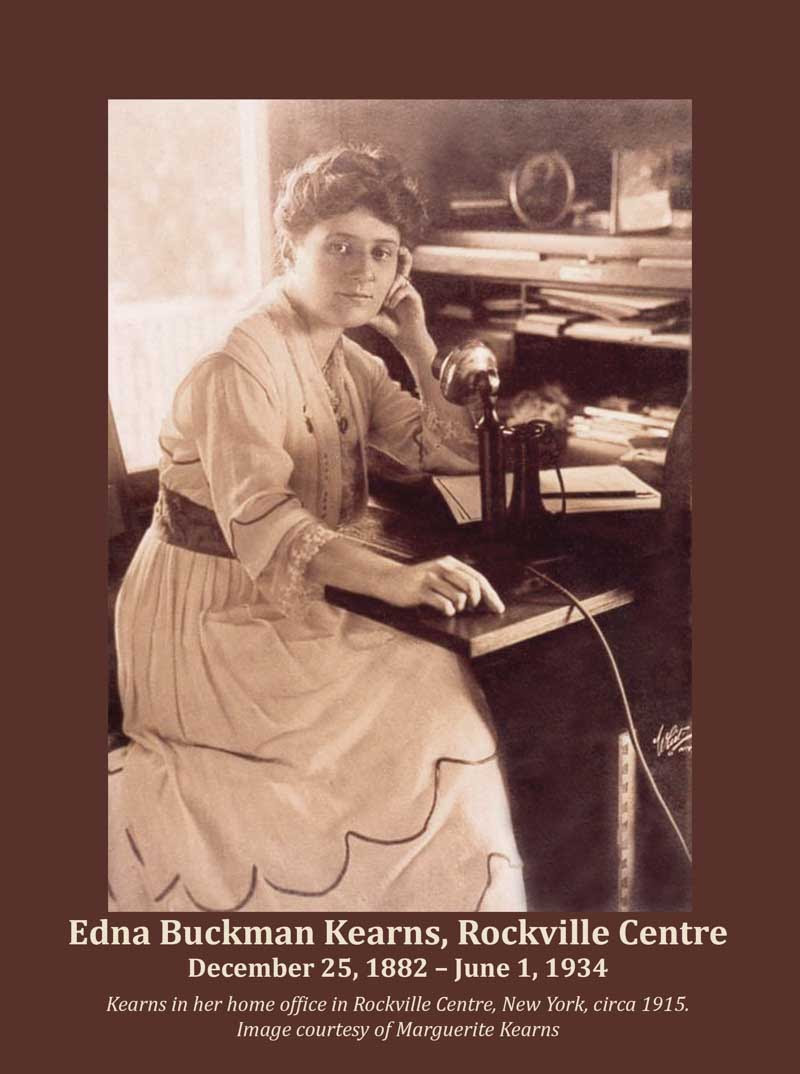
March Is Women’s History Month
Edna Buckman Kearns was a suffrage activist who worked on the 1915 and 1917 New York campaigns for votes for women, as well as on the National Woman’s Party campaign for the passage and ratification of the 19th Amendment to the U.S. Constitution. She was born in Philadelphia, and as an adult moved with her husband to New York in 1904. They lived in both New York City and Rockville Centre.
From 1910 to 1920, Kearns was a prominent grassroots suffrage organizer, working intensely as a speaker, as a press chair for local and state suffrage campaigns, and as an organizer on Long Island and in New York City. As a writer and speaker on equality and suffrage, Kearns learned newspaper reporting and editing on the fly, writing and editing suffrage news for the Brooklyn Daily Eagle and other New York City papers. She developed close relationships with news editors who published her many columns and reports. During the 1915 New York State suffrage referendum campaign, she relentlessly submitted articles in support of Votes for Women to more than twenty local newspapers.
Kearns is perhaps best known for her horse-drawn “Spirit of 1776” campaign wagon, a suffrage-movement symbol of patriotic protest. In 1913, the Brooklyn carriage company, I.S. Remson, donated an old wagon called the Spirit of 1776 to the New York State Woman Suffrage Association. Kearns hitched a horse to the wagon and took off from Manhattan to Long Island in 1913 for suffrage parades, pageants, and special organizing events. Today her historic wagon is in the collection of the New York State Museum.
The women’s suffrage movement, one of the most remarkable and successful civil rights efforts in our nation’s history, spanned 73 years and involved tens of thousands of women activists and their male allies. The year 2018 marks the 98th anniversary of the movement’s great victory, the ratification of the 19th Amendment to the U.S. Constitution in 1920, and the 101st anniversary of the New York Suffrage Amendment of 1917. In addition to Edna Buckman Kearns, our Votes for New York Women exhibit highlights many other Long Island women who were leaders in these suffrage victories.
******************************************
Visit: www.suffolkcountyhistoricalsociety.org
To View 2014 Photo of the Week pages click here.
To View 2015 Photo of the Week pages click here.
To View 2016 Photo of the Week pages click here.
To View 2017 Photo of the Week pages click here.
~~~~~~~~~~~~~~~~~~~~~~~~~~~~~~~~~~~~~~~~~~
PHOTO OF THE WEEK: February 24, 2018— FROM THE SCHS LIBRARY ARCHIVES
“How shall we know it is us without our past?”
– John Steinbeck
Laws Relating To Common Schools
by Wendy Polhemus-Annibell, Head Librarian
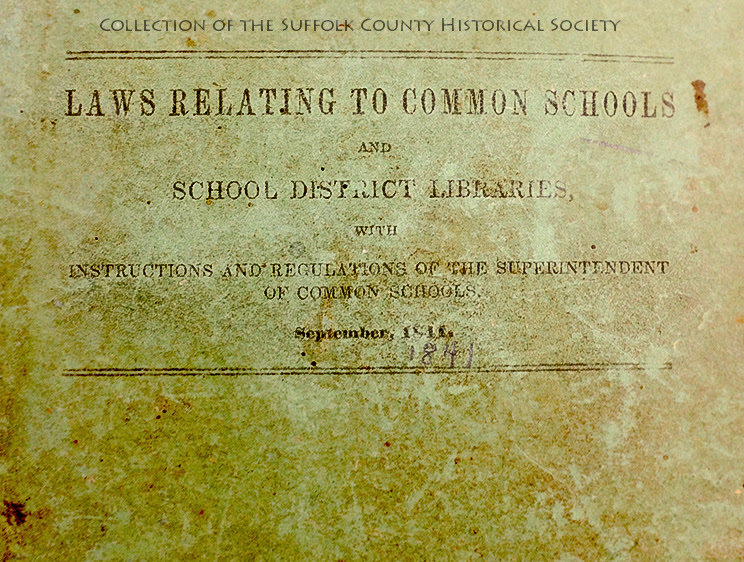
Laws Relating to Common Schools, New York State, 1841. The book, which outlines the statutes of the state of New York relating to common schools in the mid-nineteenth century, was distributed to the then-county superintendents of those schools. (From the Collection of the Suffolk County Historical Society Library Archives. Image Copyright © Suffolk County Historical Society. All rights reserved.)
New York and Suffolk County acted early on to provide education to the people. A higher form of education was decided in the state in 1784, when an act of the legislature formed the Regents of the University of the State of New York, which had the power to found schools and colleges. Four Suffolk County residents served on that Board of Regents: Samuel Buell of East Hampton, David Gelston of Bridgehampton, Ezra L’Hommedieu of Southampton, and Caleb Smith of Smithtown. The Clinton Academy in East Hampton, constructed in 1784, was the first academy in New York State to be chartered by the Board of Regents.
******************************************
Visit: www.suffolkcountyhistoricalsociety.org
To View 2014 Photo of the Week pages click here.
To View 2015 Photo of the Week pages click here.
To View 2016 Photo of the Week pages click here.
To View 2017 Photo of the Week pages click here.
~~~~~~~~~~~~~~~~~~~~~~~~~~~~~~~~~~~~~~~~~~
PHOTO OF THE WEEK: February 17, 2018— FROM THE SCHS LIBRARY ARCHIVES
“How shall we know it is us without our past?”
– John SteinbeckJohn T. Mather
by Wendy Polhemus-Annibell, Head Librarian
John T. Mather (as a Young Man with His Bicycle). (From the Collection of the Suffolk County Historical Society Library Archives. Image Copyright © Suffolk County Historical Society. All rights reserved.)
Born in Port Jefferson in 1854, John T. Mather, who never married or had children, was a businessman, a shipbuilder, and a philanthropist. Descended from a shipbuilding family, Mather formed a partnership with Owen Wood in 1879 to design and build ships. In 1881, they installed the first marine railway system driven by steam and became experts in the construction of steam-driven vessels. Mather retired from shipbuilding during the First World War, at which point the business was sold to the U.S. Shipping Board.
John T. Mather is also the founder of the community hospital in Port Jefferson that bears his name, leaving $900,000 in his will for the construction and maintenance of the facility. Before Mather Hospital opened in 1929, the residents of Port Jefferson and the surrounding hamlets had been served by a small private hospital run by Myrtle DeYoung, a nurse who would later become the first administrator of the new community hospital.
Located on North Country Road and Belle Terre Road, the newly constructed hospital had 54 beds, an emergency room, and X-ray and laboratory services. The facility was known for its modern accommodations and reasonable healthcare rates: $3 a day for lab work and typical medicine/bandage services, $2 a day for maternity care, $4 a day for a semi-private room. At its beginning, there were twenty doctors on staff, and their fee was $2 for an office visit or $3 for a home visit. It’s said that Miss DeYoung ran the hospital with the aid of a bookkeeper and clerk, and each day she personally visited with all of the patients.
******************************************
Visit: www.suffolkcountyhistoricalsociety.org
To View 2014 Photo of the Week pages click here.
To View 2015 Photo of the Week pages click here.
To View 2016 Photo of the Week pages click here.
To View 2017 Photo of the Week pages click here.
~~~~~~~~~~~~~~~~~~~~~~~~~~~~~~~~~~~~~~~~~~
PHOTO OF THE WEEK: February 10, 2018— FROM THE SCHS LIBRARY ARCHIVES
“How shall we know it is us without our past?”
– John Steinbeck
St. David AME Zion Church, Eastville
by Wendy Polhemus-Annibell, Head Librarian
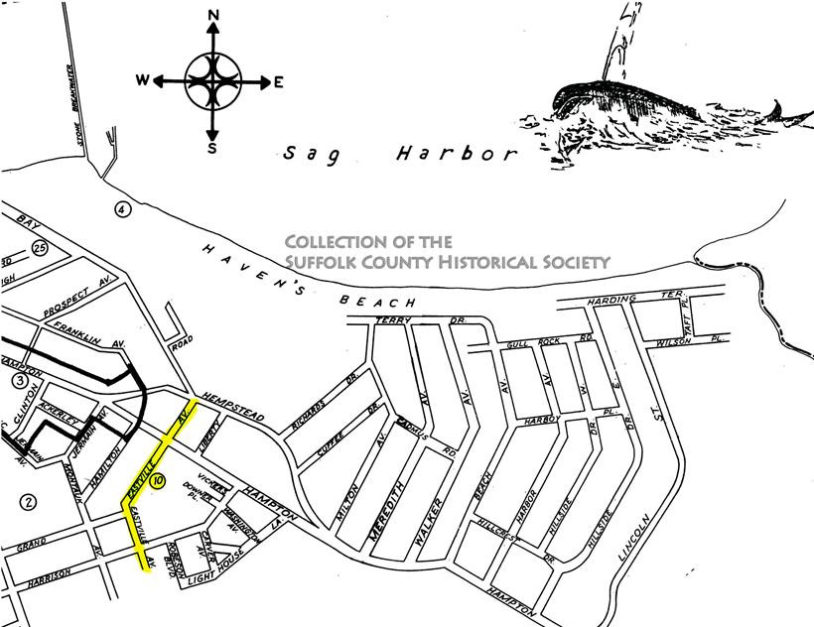
Map Showing Location of St. David AME Church, Eastville. (Map from the Collection of the Suffolk County Historical Society Library Archives; other images courtesy of Eastville Community Historical Society.)
The Eastville community of Sag Harbor is an early multiethnic area where free African Americans arrived in the early decades of the nineteenth century seeking jobs in the booming Sag Harbor whaling business. They joined Native Americans and some Europeans to settle along the streets of the community.
Lewis Cuffee, Charles Plato, and William Prime organized the St. David AME Zion Church in 1840, which served to unite the residents of Eastville. Together with David Hempstead and other members of Sag Harbor’s black and native communities, they constructed the first St. David AME Zion Church on Eastville Avenue. The founding pastor of the church, the Rev. J. P. Thompson, was a noted Abolitionist and a friend of Frederick Douglass.

The church remains in its original location (highlighted on the accompanying map section of Sag Harbor). Widely believed to have been a stop along the Underground Railroad, the church and the adjacent cemetery are maintained by the Eastville Community Historical Society, whose beginnings grew from a desire to preserve the structure. The society was instrumental in restoring the exterior of the building, the tin ceiling, and the stained glass windows of the church. Past members of the church and many whalers of color are buried in St. David’s cemetery. Today Eastville retains its ethnic mix, while preserving its modest character amidst the wealth of the Hamptons.
——————————————-
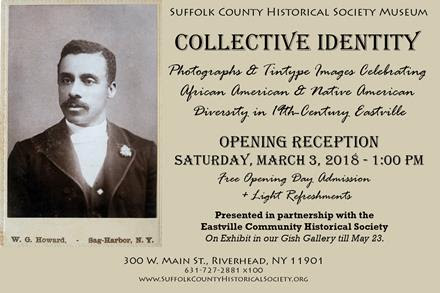
Join us on Saturday, March 3, 1:00 pm , for an opening reception.
Collective Identity will showcase Photographs & Tintype Images of African and Native American Diversity in 19th-Century Eastville. Free opening day admission. Light refreshments will be served. On exhibit in our Gish Gallery: March 3 – May 23, 2018.
******************************************
Visit: www.suffolkcountyhistoricalsociety.org
To View 2014 Photo of the Week pages click here.
To View 2015 Photo of the Week pages click here.
To View 2016 Photo of the Week pages click here.
To View 2017 Photo of the Week pages click here.
~~~~~~~~~~~~~~~~~~~~~~~~~~~~~~~~~~~~~~~~~~
PHOTO OF THE WEEK: January 27, 2018— FROM THE SCHS LIBRARY ARCHIVES
“How shall we know it is us without our past?”
– John SteinbeckPeconic Bay Impressionists
by Wendy Polhemus-Annibell, Head Librarian
Mattituck Barn by Caroline M. Bell. (From the Collection of the Suffolk County Historical Society Museum. Image copyright © Suffolk County Historical Society. All rights reserved.)
Caroline M. Bell (1874-1970), a painter and the leader of a group of about thirty North Fork artists known as the Peconic Bay Impressionists, is among the local artists featured in our new exhibit, Spotlight Series: The Paintings, which will open on Saturday, February 10, at 1:00 pm with a free reception.
The Peconic Bay Impressionists included mostly women who lived and worked in the hamlets of the North Fork and often painted together as a group in the familiar outdoor settings in which they grew up. Many of the artists who were born and raised on the North Fork could trace their ancestors back to the beginnings of Southold Town, bearing such familiar names as Carrie Carter Wells, Marguerite Moore Hawkins, Franklin Glover Brooks, Clara Wells Howell, Julia Wickham, and Annie Young, to name a few.
Caroline “Dotty” Bell had art studios in the Love Lane, Mattituck area, and during her lifetime her works were shown in over seventy-five exhibits. Bell died at the age of 96 and is buried in New Bethany Cemetery in Mattituck.
| ——————————————- |
 Join us on Saturday, Feb. 10, 1:00 pm, for an opening reception: Spotlight Series: The Paintings will showccase paintings from our permanent collection, chosen for their beauty, quality, and community connections.
Join us on Saturday, Feb. 10, 1:00 pm, for an opening reception: Spotlight Series: The Paintings will showccase paintings from our permanent collection, chosen for their beauty, quality, and community connections.
———————————————-

Join us on Saturday, March 10, 2018 for Long Island and the Great War: A Symposium – 8:30 am – 4:00 pm, featuring a panel of distinguished World War I researchers and authorities on the Long Island experience during the war, as well as a concluding curator’s tour of our WWI centennial exhibit. Morning refreshments and a light lunch will be served. Cost is $25. RSVP Required: 631-727-2881 x100.
******************************************
Visit: www.suffolkcountyhistoricalsociety.org
To View 2014 Photo of the Week pages click here.
To View 2015 Photo of the Week pages click here.
To View 2016 Photo of the Week pages click here.
To View 2017 Photo of the Week pages click here.
~~~~~~~~~~~~~~~~~~~~~~~~~~~~~~~~~~~~~~~~~~
PHOTO OF THE WEEK: January 27, 2018— FROM THE SCHS LIBRARY ARCHIVES
“How shall we know it is us without our past?”
– John Steinbeck
Cedar Point Lighthouse, Sag Harbor
by Wendy Polhemus-Annibell, Head Librarian
[To view Fullerton photo, visit SCHS website]
Cedar Island Lighthouse, Sag Harbor, by Hal B. Fullerton, c. 1898. (From the Harry T. Tuthill Fullerton Collection of the Suffolk County Historical Society Library Archives. Image copyright © Suffolk County Historical Society. All rights reserved.)
Standing between the South Fork and Shelter Island, Cedar Island posed a danger to ships entering and leaving Sag Harbor in the nineteenth century. The federal government thus purchased the island for $200 from the Town of East Hampton in 1838, and by 1839 had built the original Cedar Island Lighthouse on the north side of the island. By 1851 the light had an effective range of 12 miles. Its nine lamps cast their light from a height of 32 feet, leading whaling ships and fishing boats home to Sag Harbor.
Congress authorized a rebuilding of the lighthouse in 1867, and by 1868 a new L-shaped lighthouse with a square tower was standing on the island. It is shown here in our 1898 photograph by Hal B. Fullerton; although the structure still stands today, it is in need of restoration. In 1967, the lighthouse was purchased by Suffolk County to become part of Cedar Point County Park, but in 1974 it was severely damaged in a fire and boarded up. In 2017, the Suffolk County Legislature approved $500,000 for the renovation of the lighthouse’s roof, exterior, and foundation pier.
******************************************
Visit: www.suffolkcountyhistoricalsociety.org
To View 2014 Photo of the Week pages click here.
To View 2015 Photo of the Week pages click here.
To View 2016 Photo of the Week pages click here.
To View 2017 Photo of the Week pages click here.
~~~~~~~~~~~~~~~~~~~~~~~~~~~~~~~~~~~~~~~~~~
PHOTO OF THE WEEK: January 20, 2018— FROM THE SCHS LIBRARY ARCHIVES
“How shall we know it is us without our past?”
– John SteinbeckModern Times, 1851 / 1864
by Wendy Polhemus-Annibell, Head Librarian
Charles A. Codman, 1911. (From the Modern Times Collection of the Suffolk County Historical Society Library Archives. Image copyright © Suffolk County Historical Society. All rights reserved.)
Charles A. Codman, shown here as if lecturing, was a highly respected citizen and a pioneer settler of the Modern Times colony and later of the village of Brentwood. He and his wife built a house on the corner of Second Avenue and Brentwood Road, where he lived for nearly 60 years. The structure was over a hundred years old when it was eventually torn down for commercial development. An artist and a writer, Codman’s original handwritten manuscript entitled “A History of Modern Times,” and a copy of his “Legend of the Red Owl,” are both in our collection, along with his framed color drawing of the red owl and various other documents. According to the red owl legend, on a cold winter night in 1877, a small red owl visited Codman and revealed itself to be the spirit of an Indian warrior whose bones remained unburied near the back of Codman’s house. Codman found the bones and buried them as instructed by the owl, who returned one more time to thank Codman for a job well done.
Modern Times was founded in 1851 by Josiah Warren, a Boston-born reformer and nonviolent anarchist who advocated for the “sovereignty of the individual.” He purchased over 700 acres of land on the south side of the LIRR tracks in the area that is present-day Brentwood. He laid out streets and advertised for pioneers. The colony of 100 persons settled in the new village, cleared the land, built log cabins, and planted large gardens that became their chief means of support. In 1857, the population of Modern Times had doubled to 200, and the colony had a number of thriving businesses–the Time Store (a general store/supermarket), a printing plant, a carriage factory, a harness and saddlery shop, a furniture-making factory, and a box factory. For a number of years Modern Times held a peaceful existence free of government, jails, rules, and regulations. All this was disrupted when the economic panic of 1857 and the Civil War brought an end to the colony. Thus by 1864, Modern Times became Brentwood.
******************************************
Visit: www.suffolkcountyhistoricalsociety.org
To View 2014 Photo of the Week pages click here.
To View 2015 Photo of the Week pages click here.
To View 2016 Photo of the Week pages click here.
To View 2017 Photo of the Week pages click here.
~~~~~~~~~~~~~~~~~~~~~~~~~~~~~~~~~~~~~~~~~~
PHOTO OF THE WEEK: January 13, 2018— FROM THE SCHS LIBRARY ARCHIVES
“How shall we know it is us without our past?”
– John SteinbeckOld Oyster Packing House and Dock, New Suffolk
by Wendy Polhemus-Annibell, Head Librarian
Old Oyster Packing House and Dock, New Suffolk. (From the Collection of the Suffolk County Historical Society Library Archives. Image Copyright © Suffolk County Historical Society. All rights reserved.)
The oyster packing house burned down in 1980, but before that time it was home to the Standard Oyster Company at New Suffolk, a subsidiary of the Andrew Radel Oyster Company, planters and wholesale shippers of Robbins Island Oysters.
According to an informational brochure published by the company in 1935 (also within our collection), in just a few hours a crew of fourteen men on a steamboat was capable of catching and unloading 3,000 bushels of oysters a day from the Great Peconic Bay. The oysters were harvested with a dredge or mesh basket dropped overboard and dragged over the oyster beds for 100 yards to catch the oysters. After the dredge was emptied onto the boat, it would be lowered for another haul into the deep salty oyster beds of the bay. The oysters were then taken to the packing house, cleaned, assorted for size, and packed into barrels for same-day shipping. “That’s one reason they taste so good!”
Suggested Reading: Robbins Island Oysters, New Suffolk, Long Island, by Standard Oyster Company, Sole Producers of Robbins Island Oysters, 1935.
******************************************
Visit: www.suffolkcountyhistoricalsociety.org
To View 2014 Photo of the Week pages click here.
To View 2015 Photo of the Week pages click here.
To View 2016 Photo of the Week pages click here.
To View 2017 Photo of the Week pages click here.
~~~~~~~~~~~~~~~~~~~~~~~~~~~~~~~~~~~~~~~~~~
PHOTO OF THE WEEK: January 6, 2018— FROM THE SCHS LIBRARY ARCHIVES
“How shall we know it is us without our past?”
– John Steinbeck
The Great Blizzard of 1888
by Wendy Polhemus-Annibell, Head Librarian

The Russell Snow Plow & Hand Flanger, Riverhead, undated.It was because of the Great Blizzard of 1888 that the LIRR acquired snow plows to help clear the tracks during major snow events. (Image from the Orville Young Photograph Collection of the Suffolk County Historical Society Library Archives [211.4.399]. Copyright © Suffolk County Historical Society. All rights reserved.)
Nearly 130 years later, the Great Blizzard of 1888 is still the storm against which all others are measured. The storm, which began on March 11 and lasted for 72 hours, devastated the entire Northeast. The three days of howling winds, blinding snow, and Artic temperatures came without warning, burying the area in giant snowdrifts, knocking out telephone lines, paralyzing the Long Island Railroad, and leaving many people stranded in their homes or businesses. About 400 deaths in the Northeast were attributed to the storm, including many stranded pedestrians and commuters.
Long Island was hit hard with high winds and more than 40-50 inches of snow. Southold had “no communication by train, mail, or telegraph” for days: “Our streets are blocked by snow drifts varying from five to fifteen feet in height,” the Traveler reported on March 16, 1888. Main Street in Huntington was “filled up with 10 or 15 feet of snow,” recounts an eyewitness in Blizzard: The Great Storm of ’88 (1988).
******************************************
Visit: www.suffolkcountyhistoricalsociety.org
To View 2014 Photo of the Week pages click here.
To View 2015 Photo of the Week pages click here.
To View 2016 Photo of the Week pages click here.
To View 2017 Photo of the Week pages click here.
————————————–

Copyright © 2017 Suffolk County Historical Society. All rights reserved.


